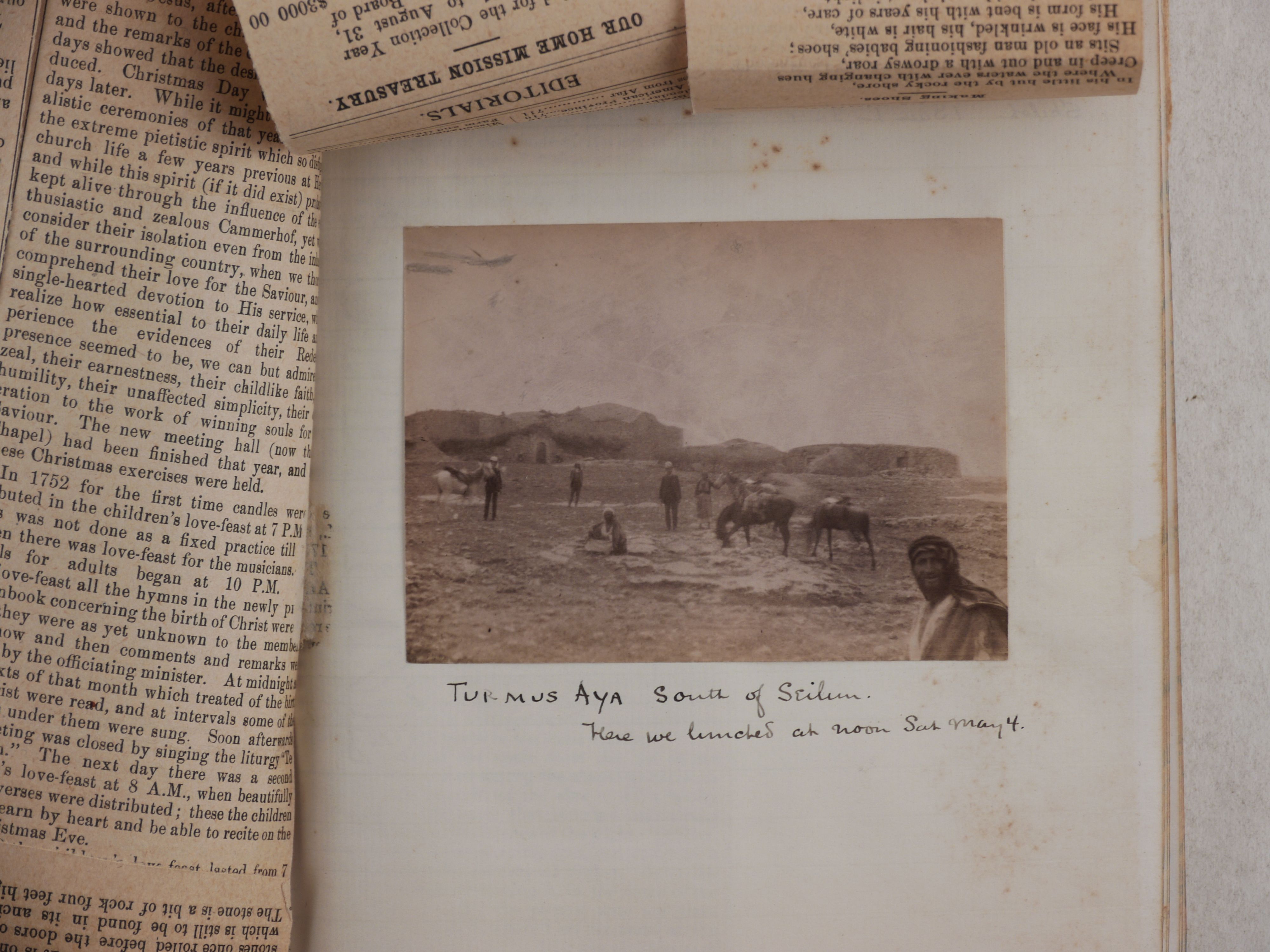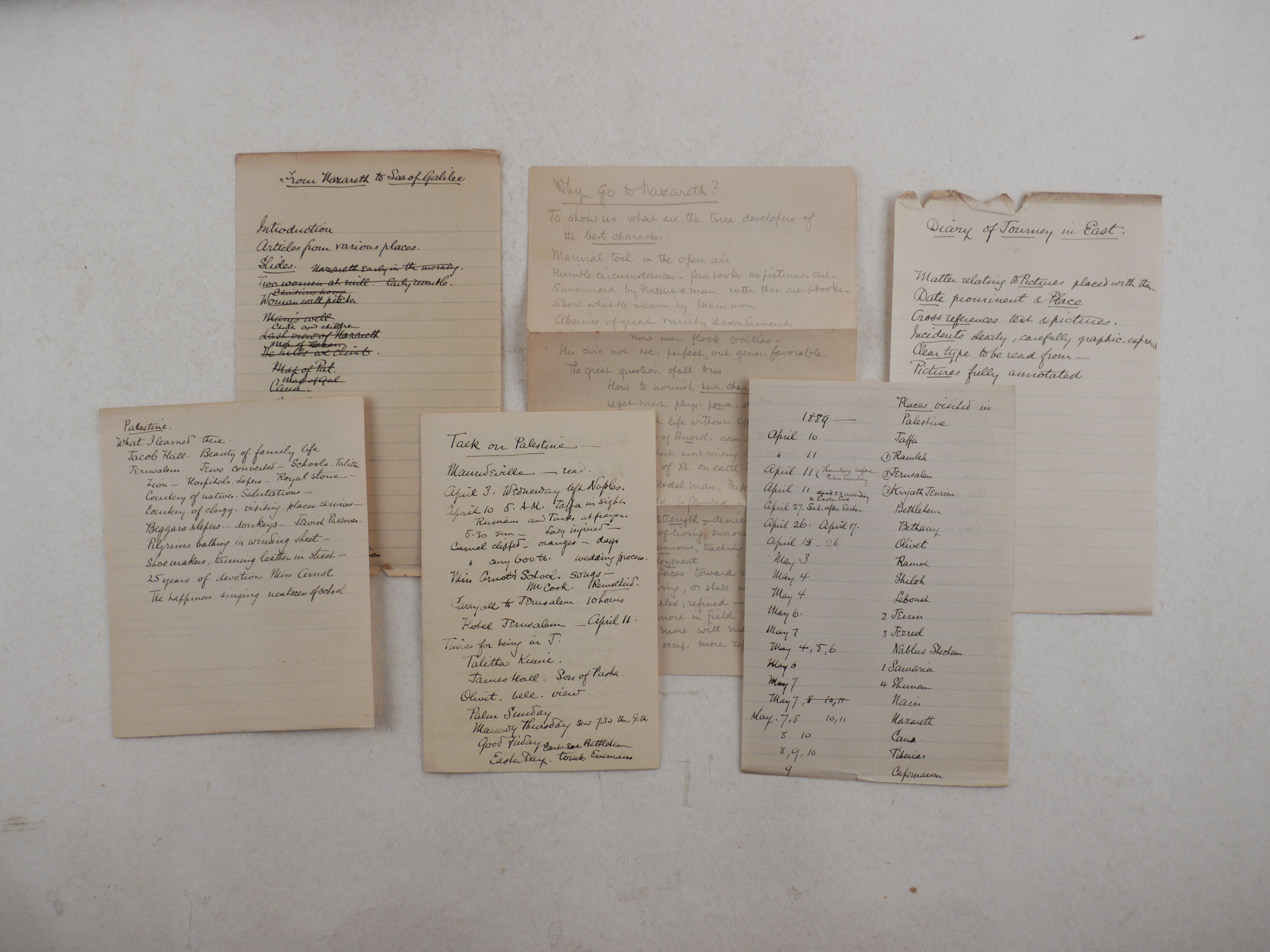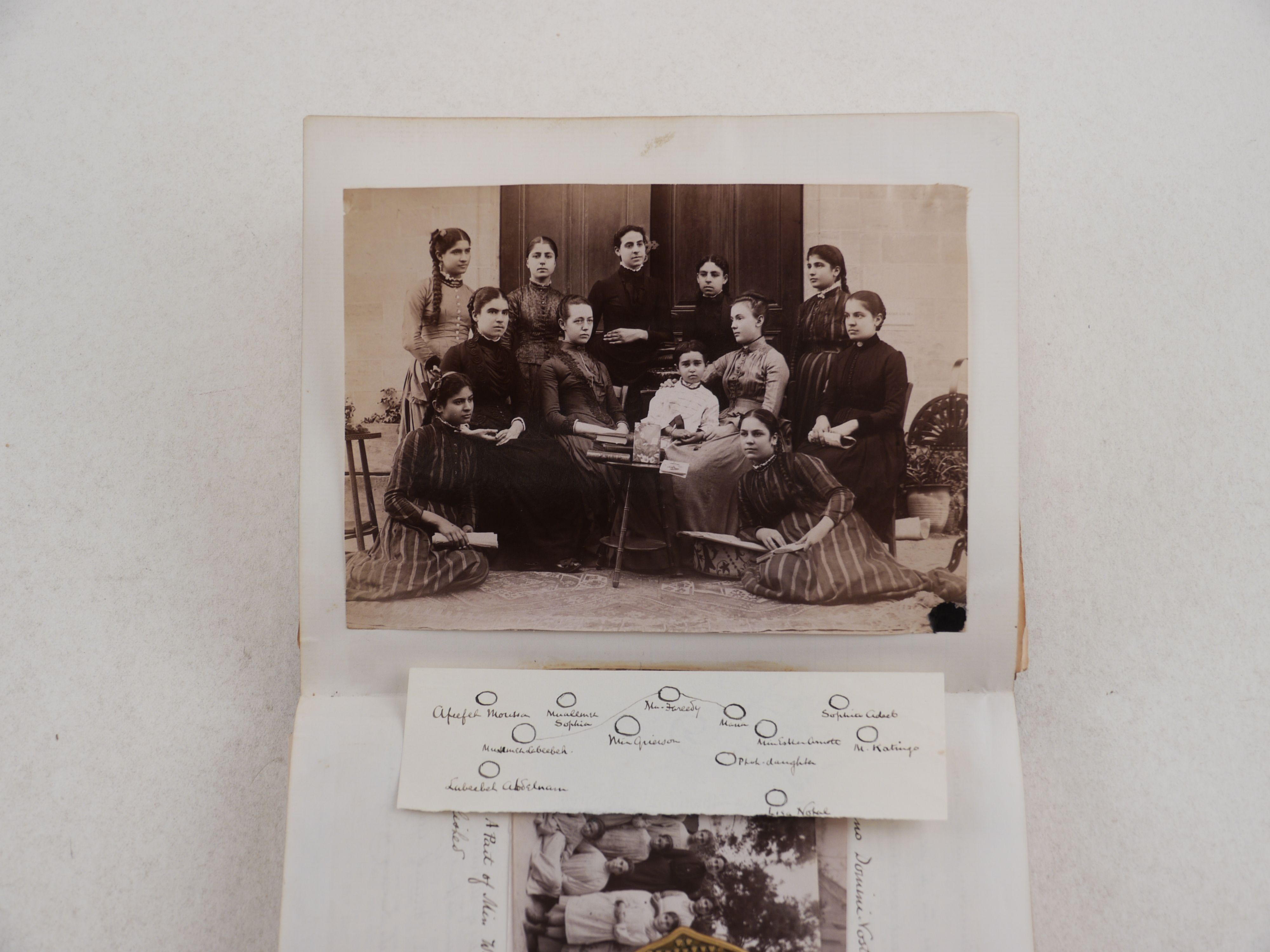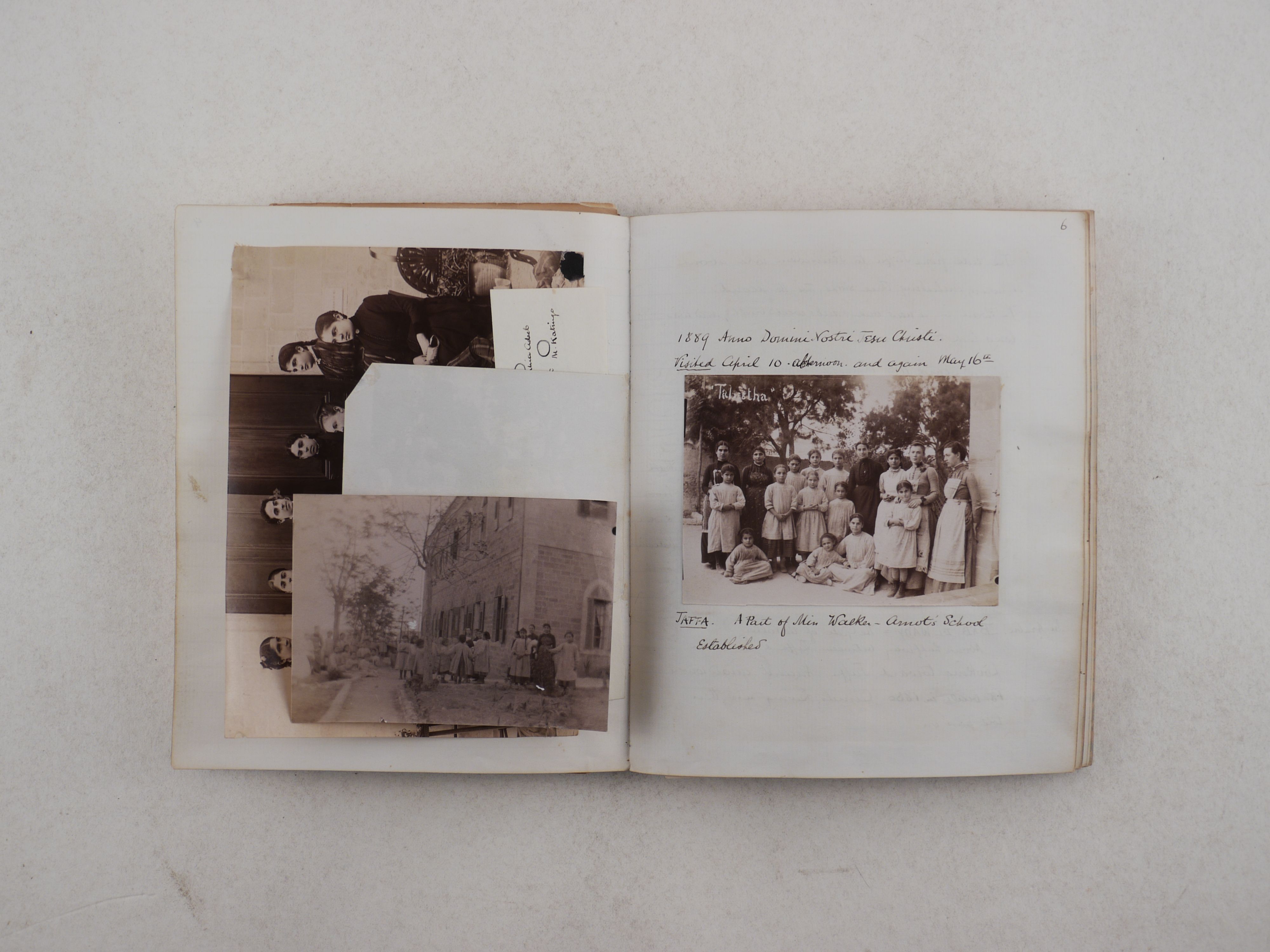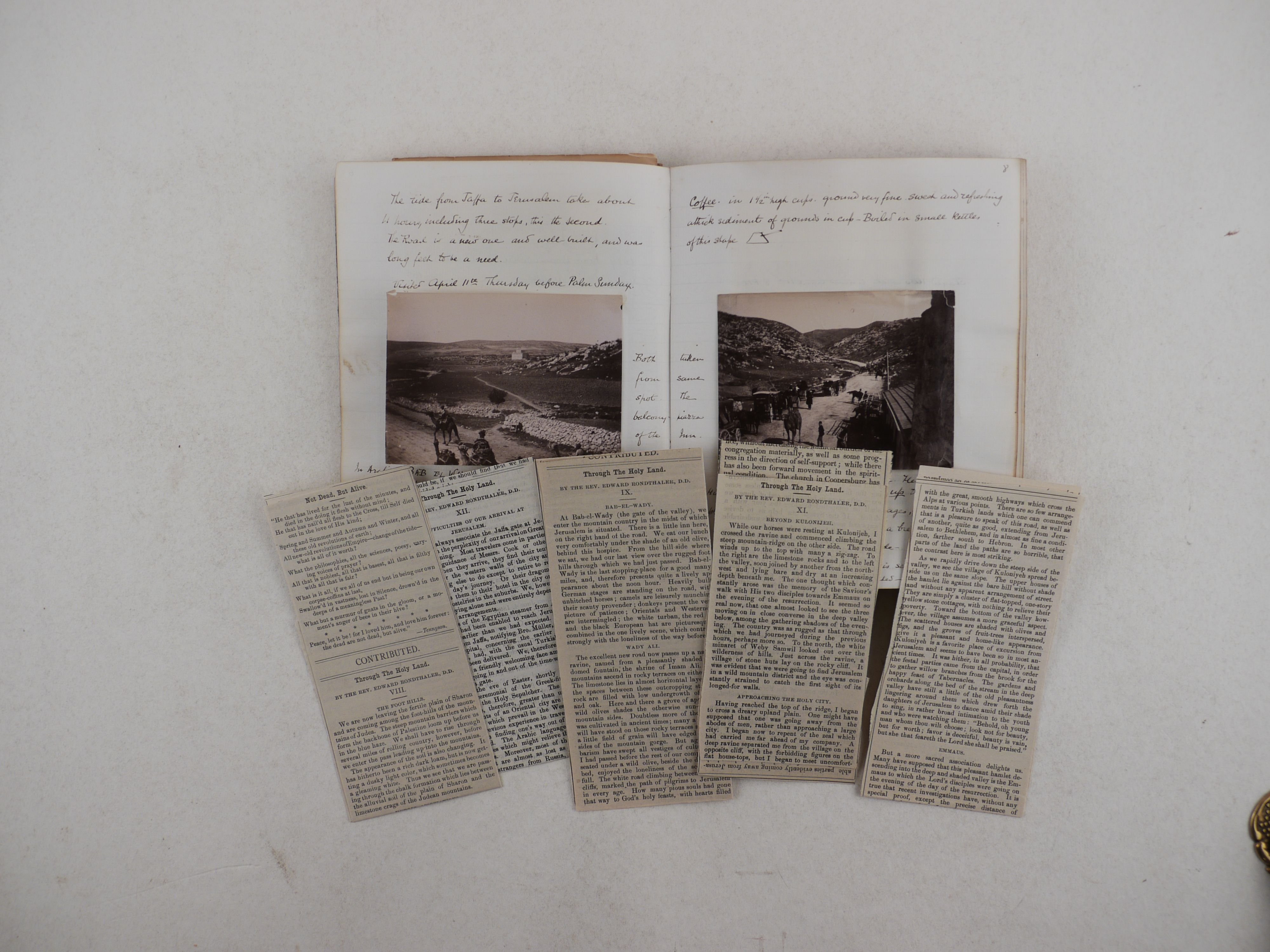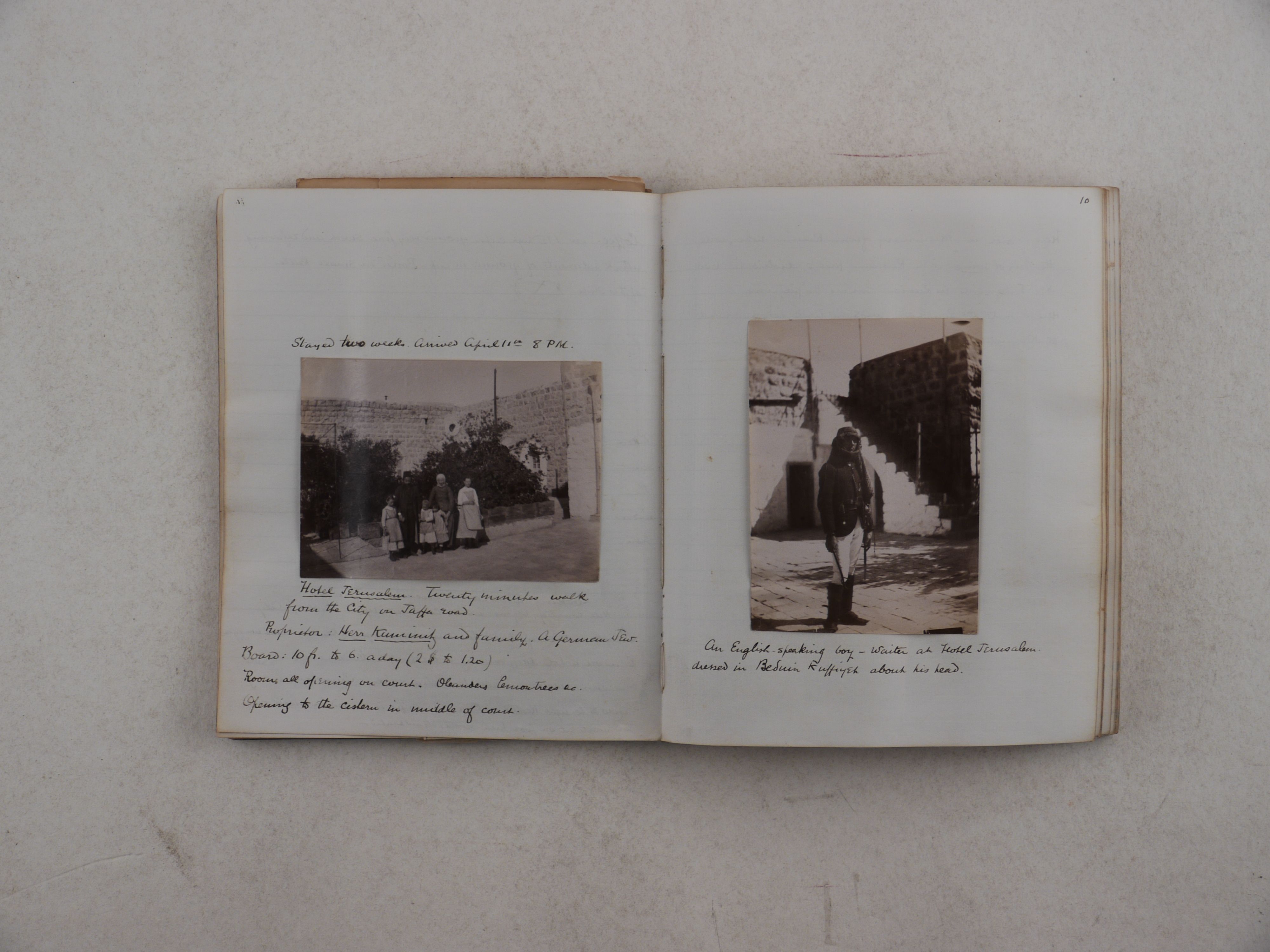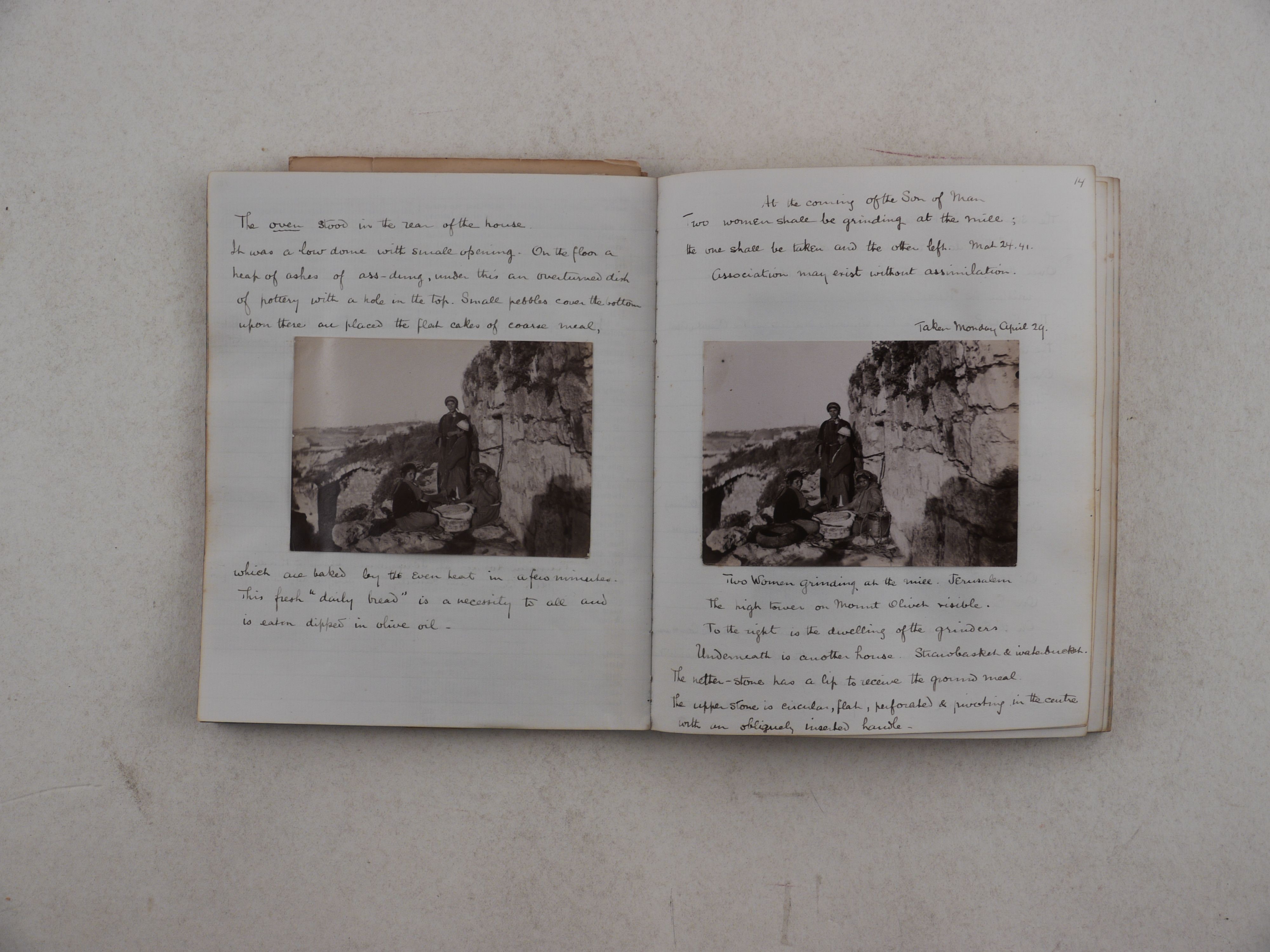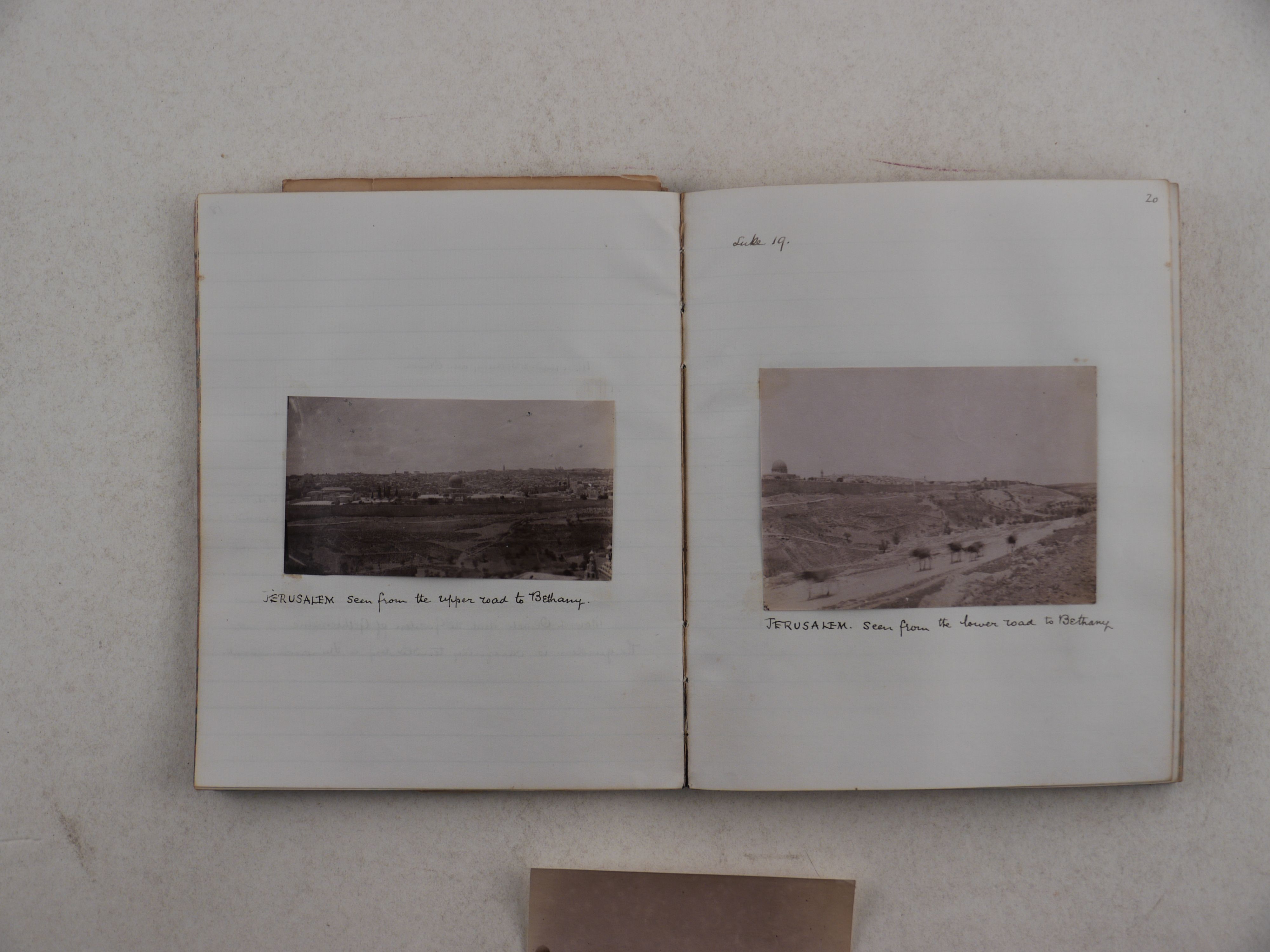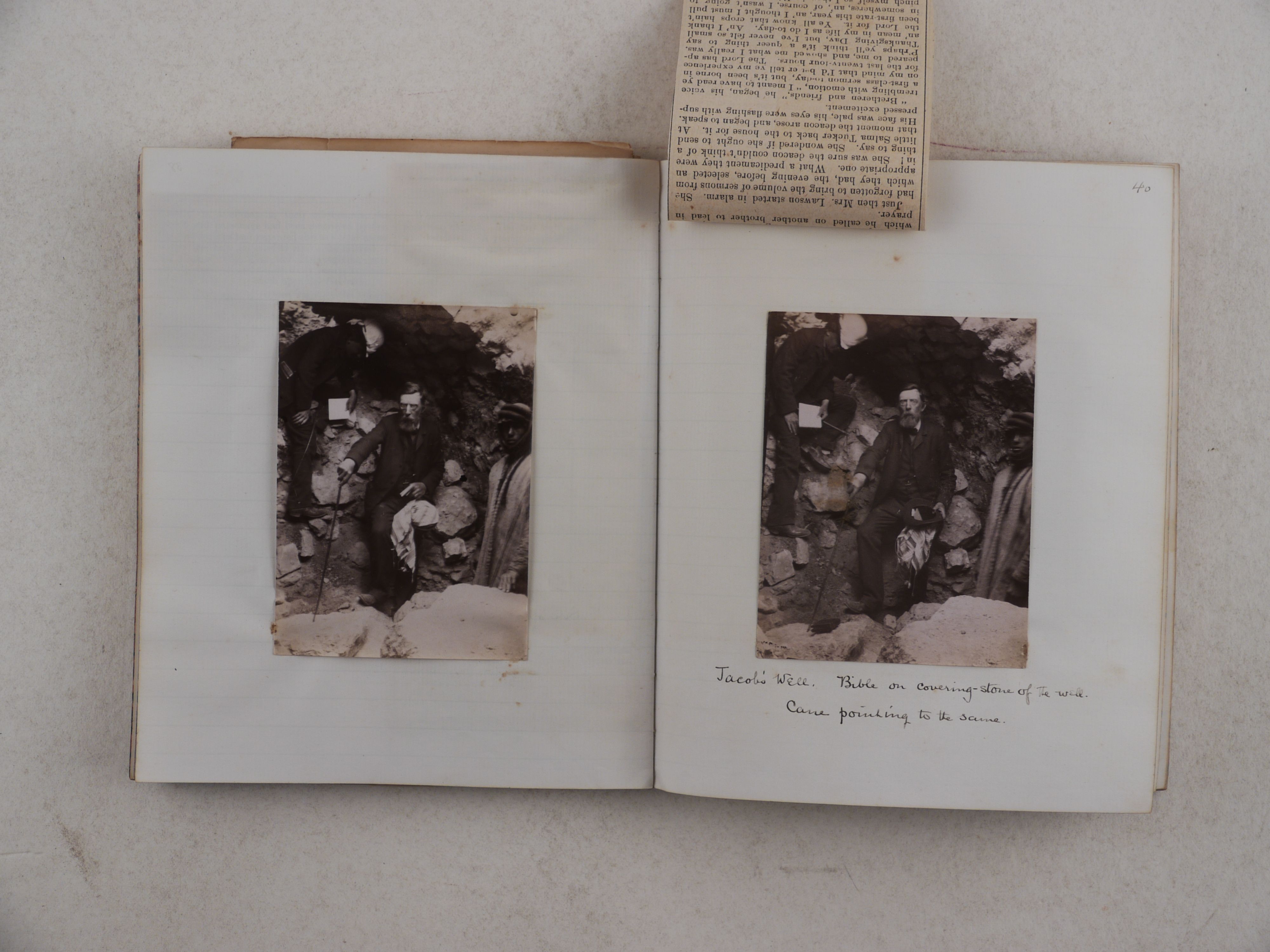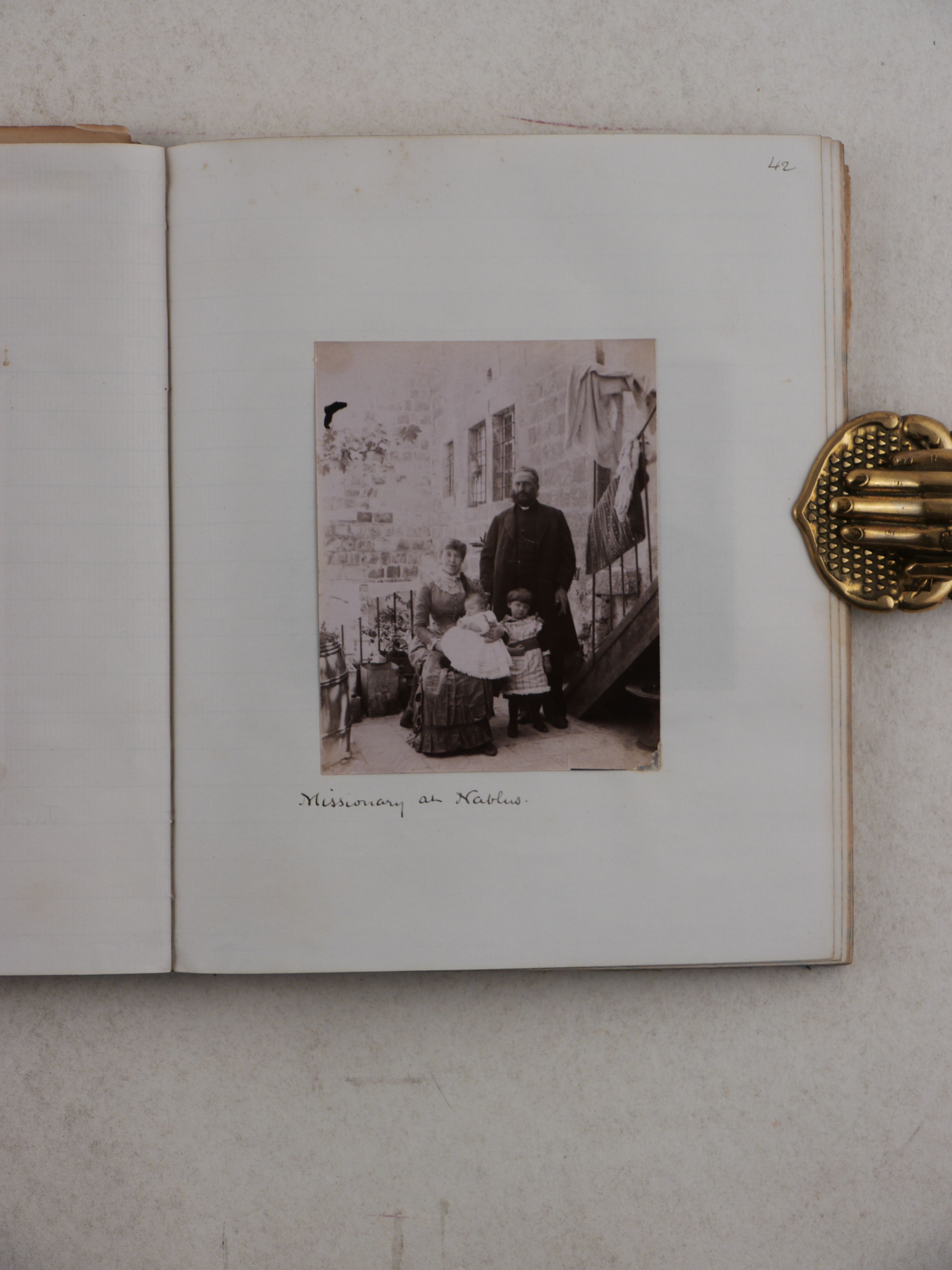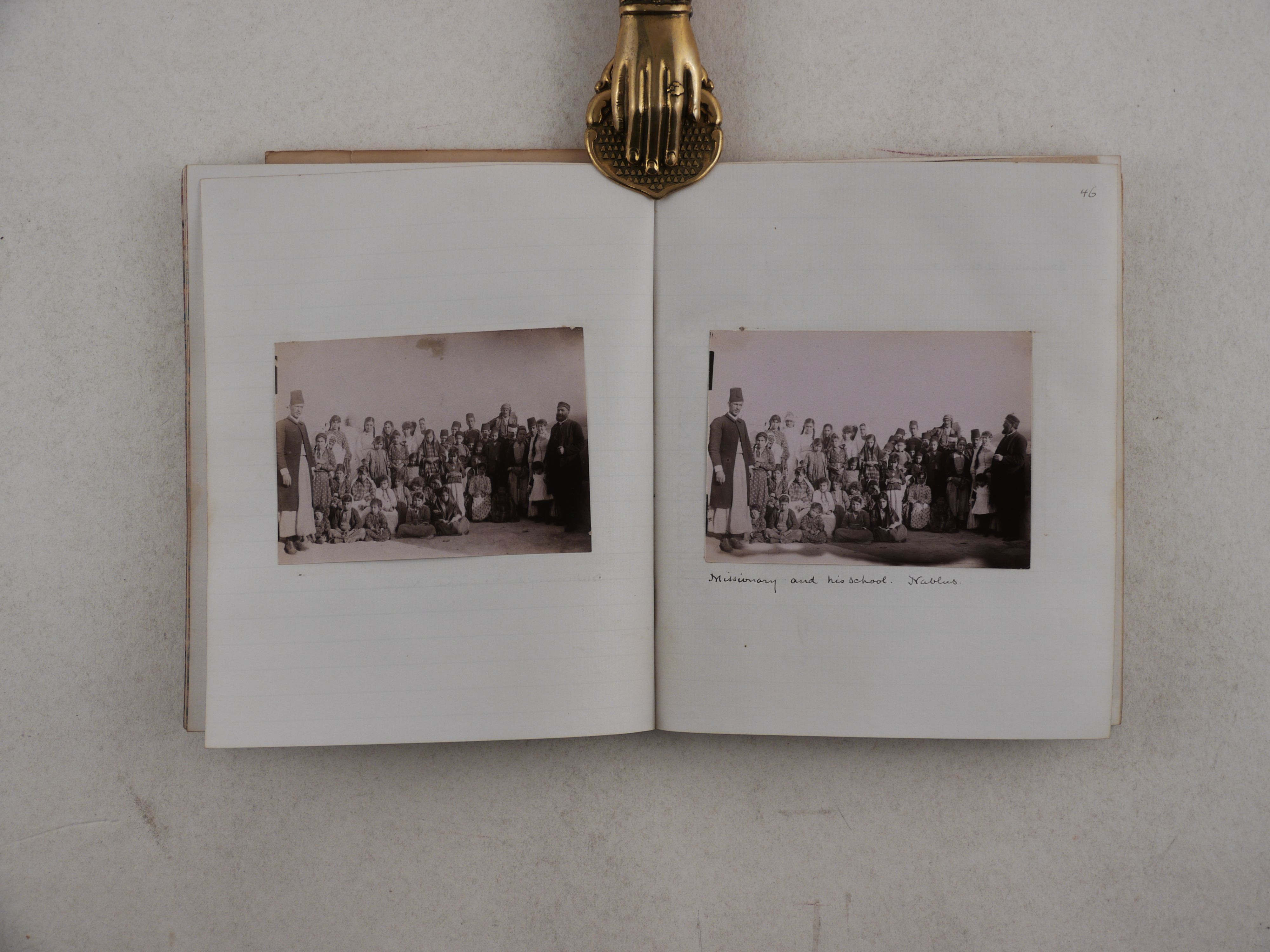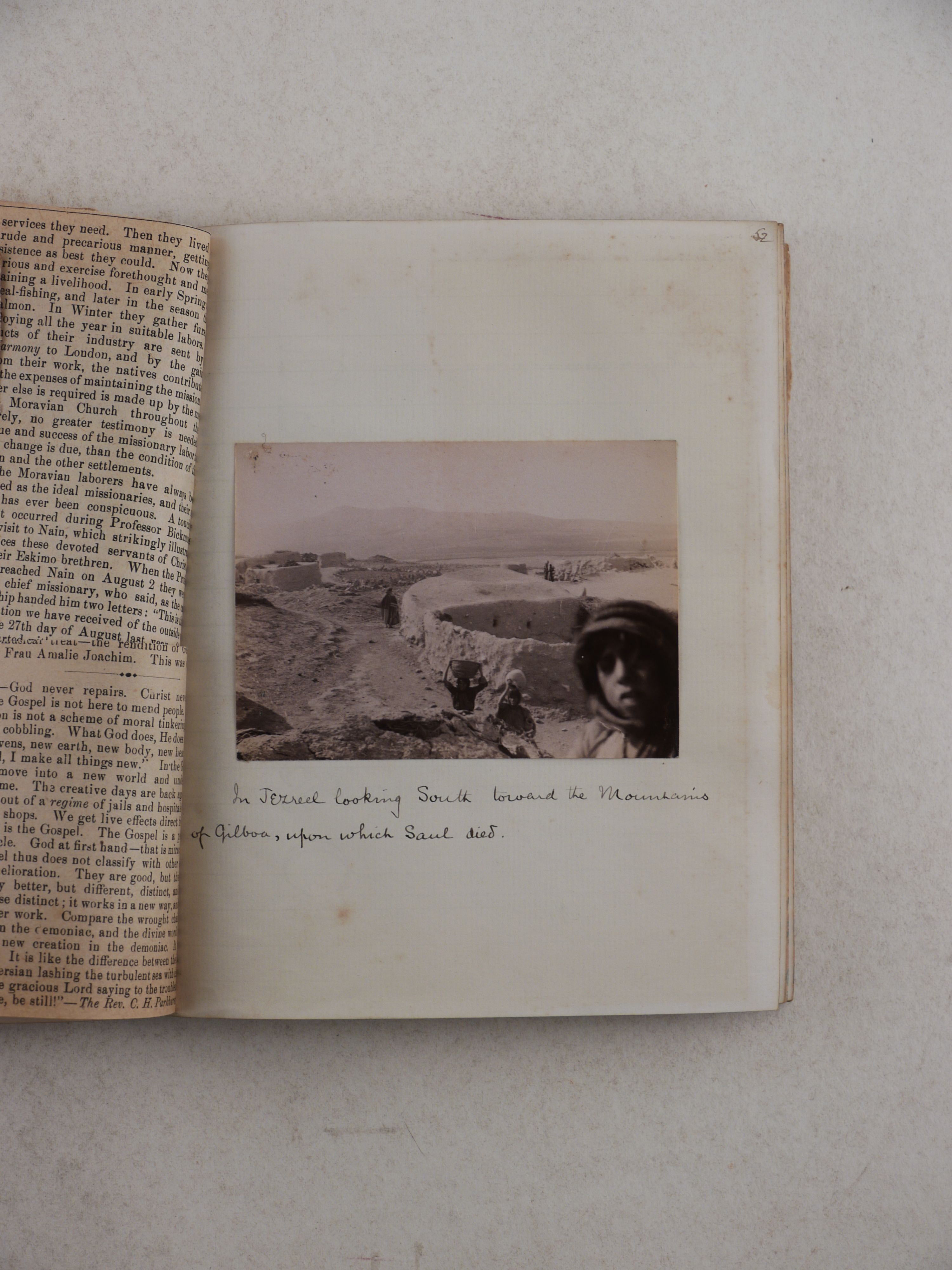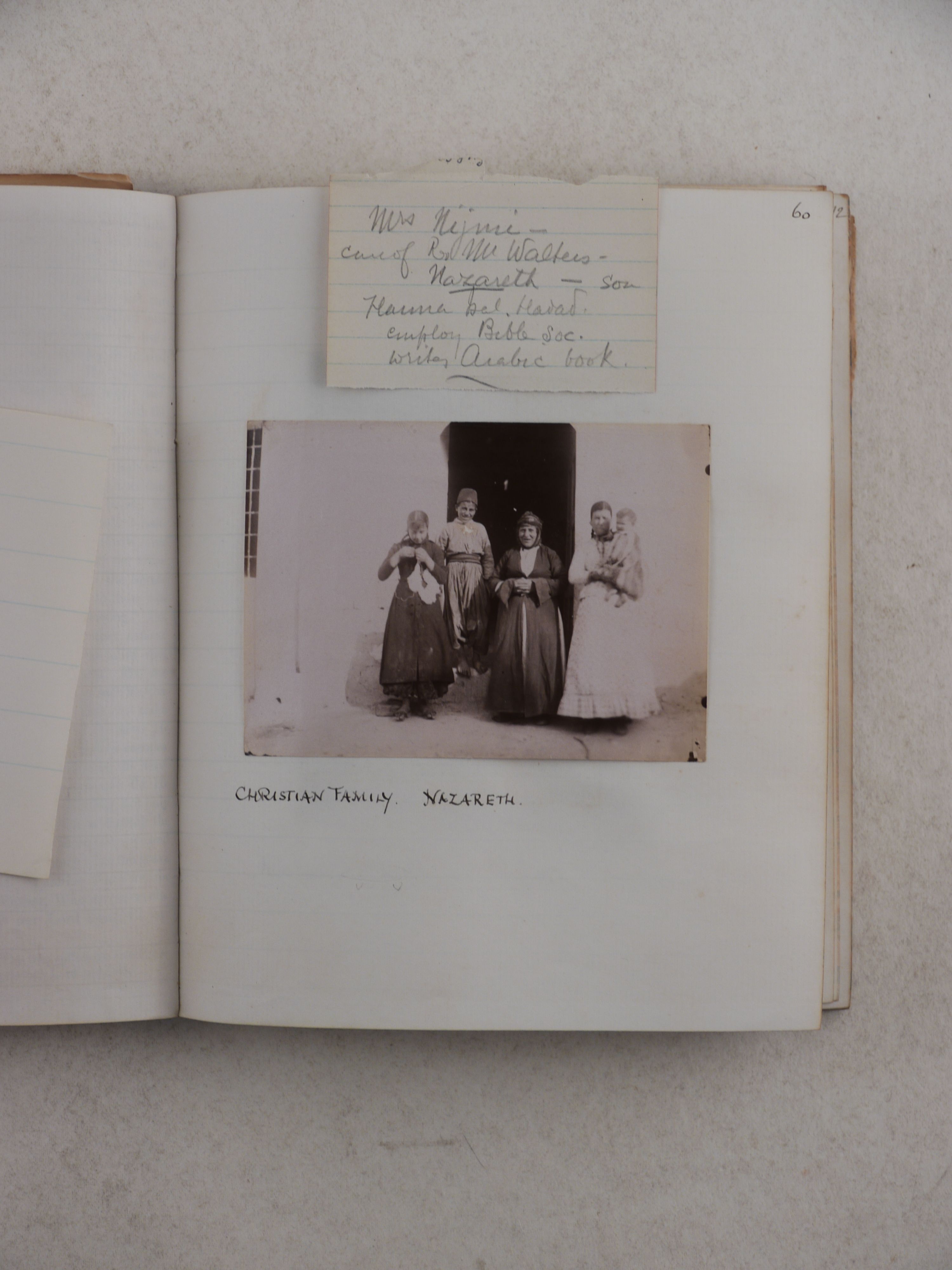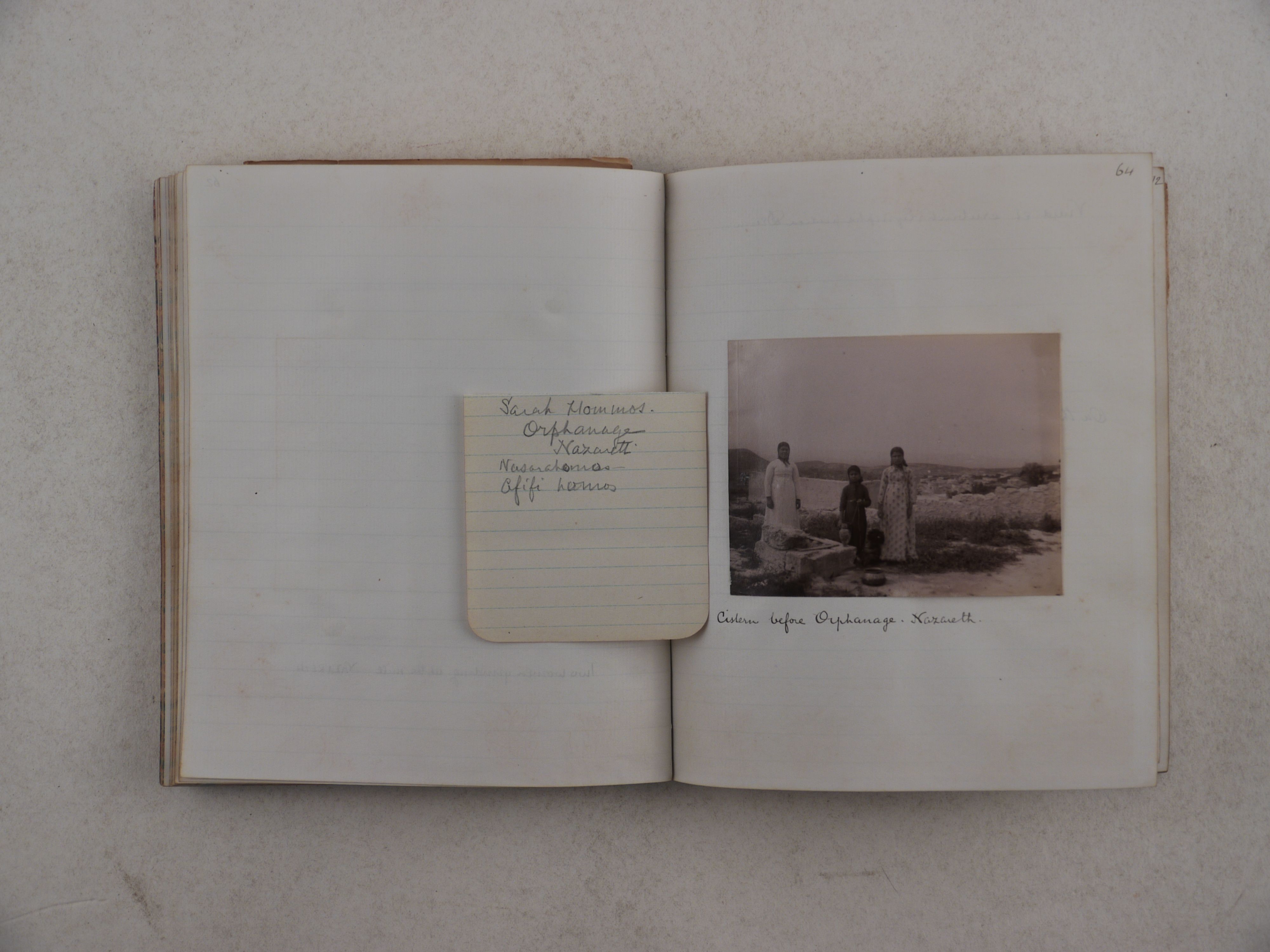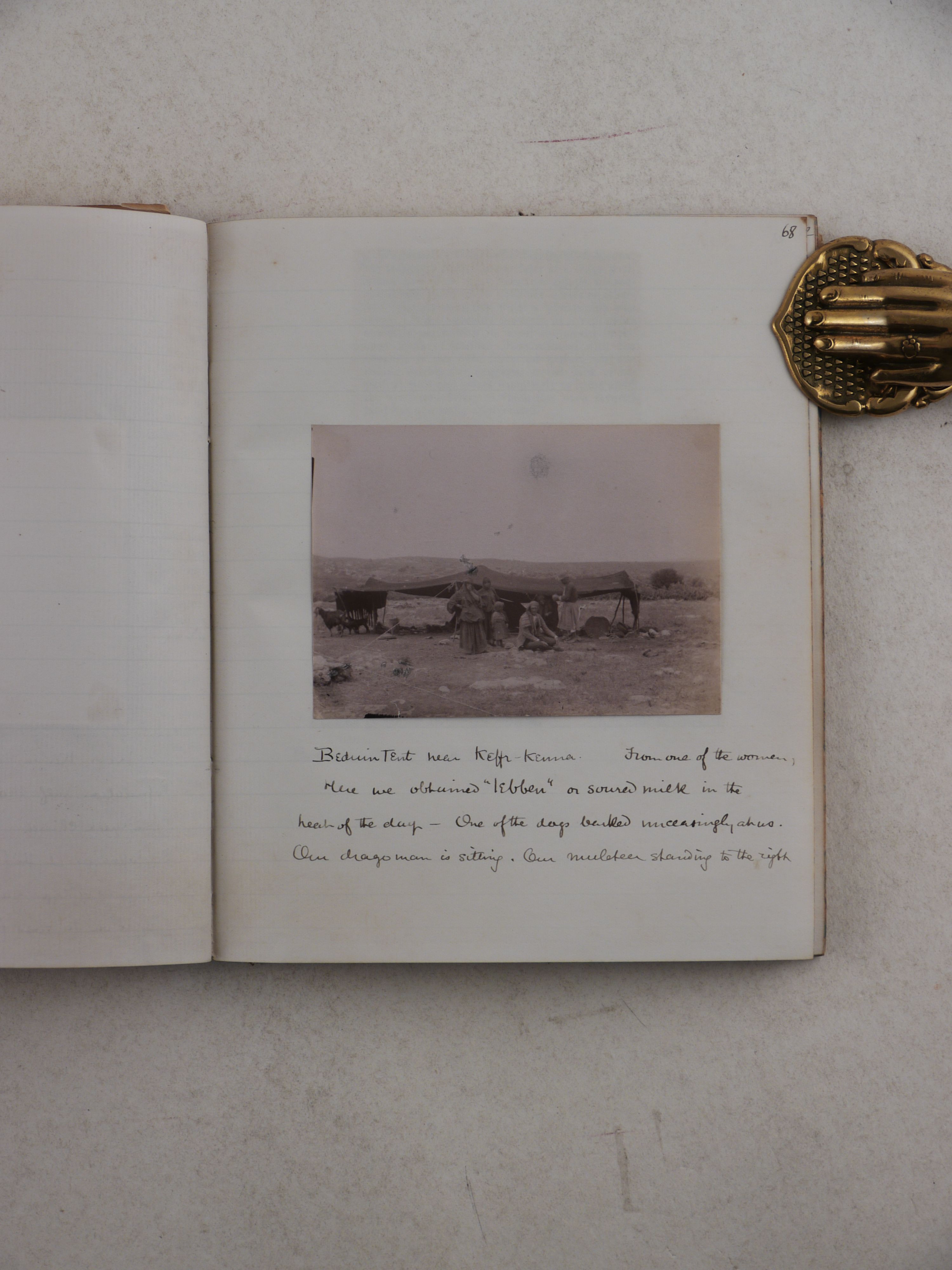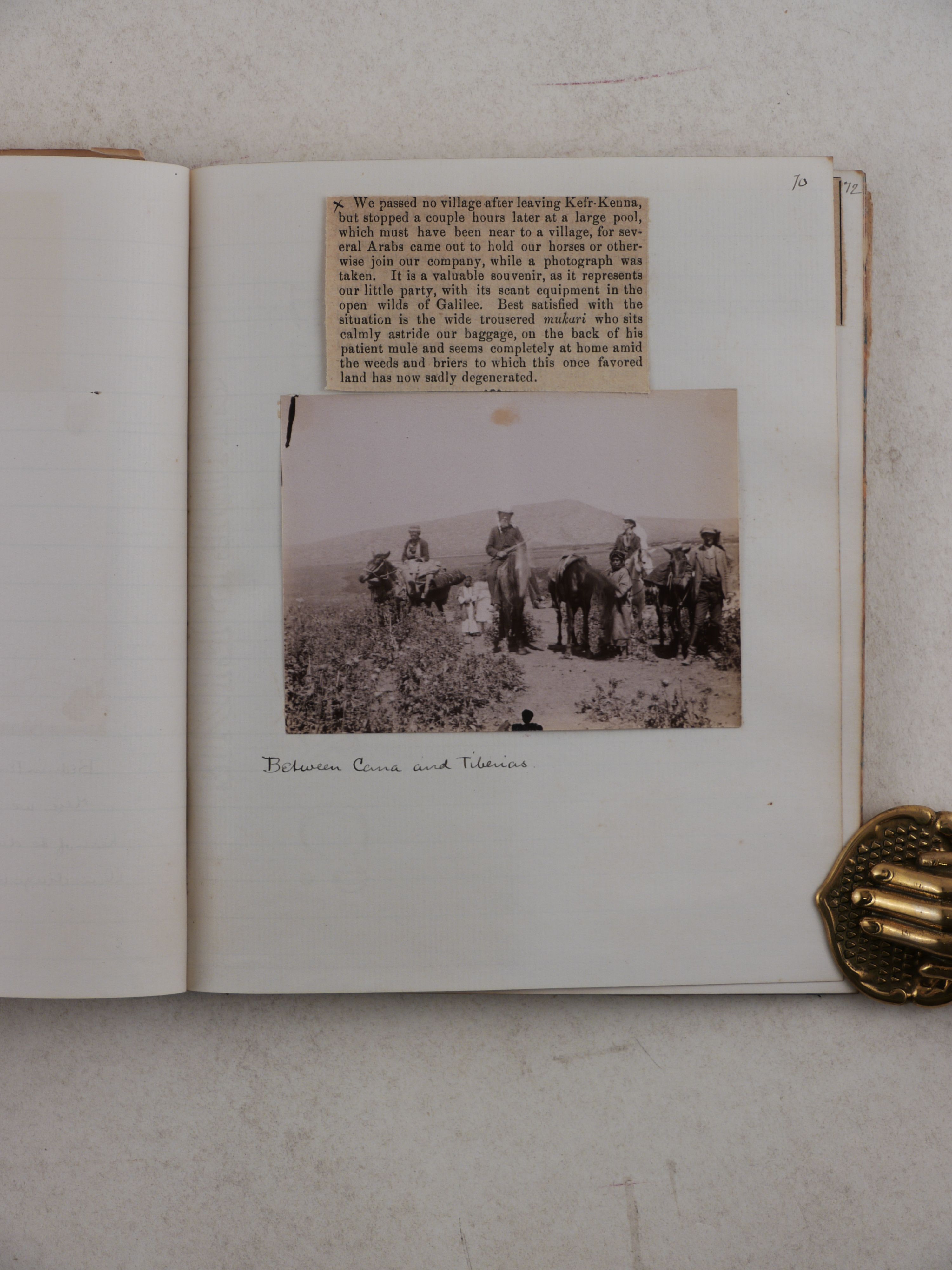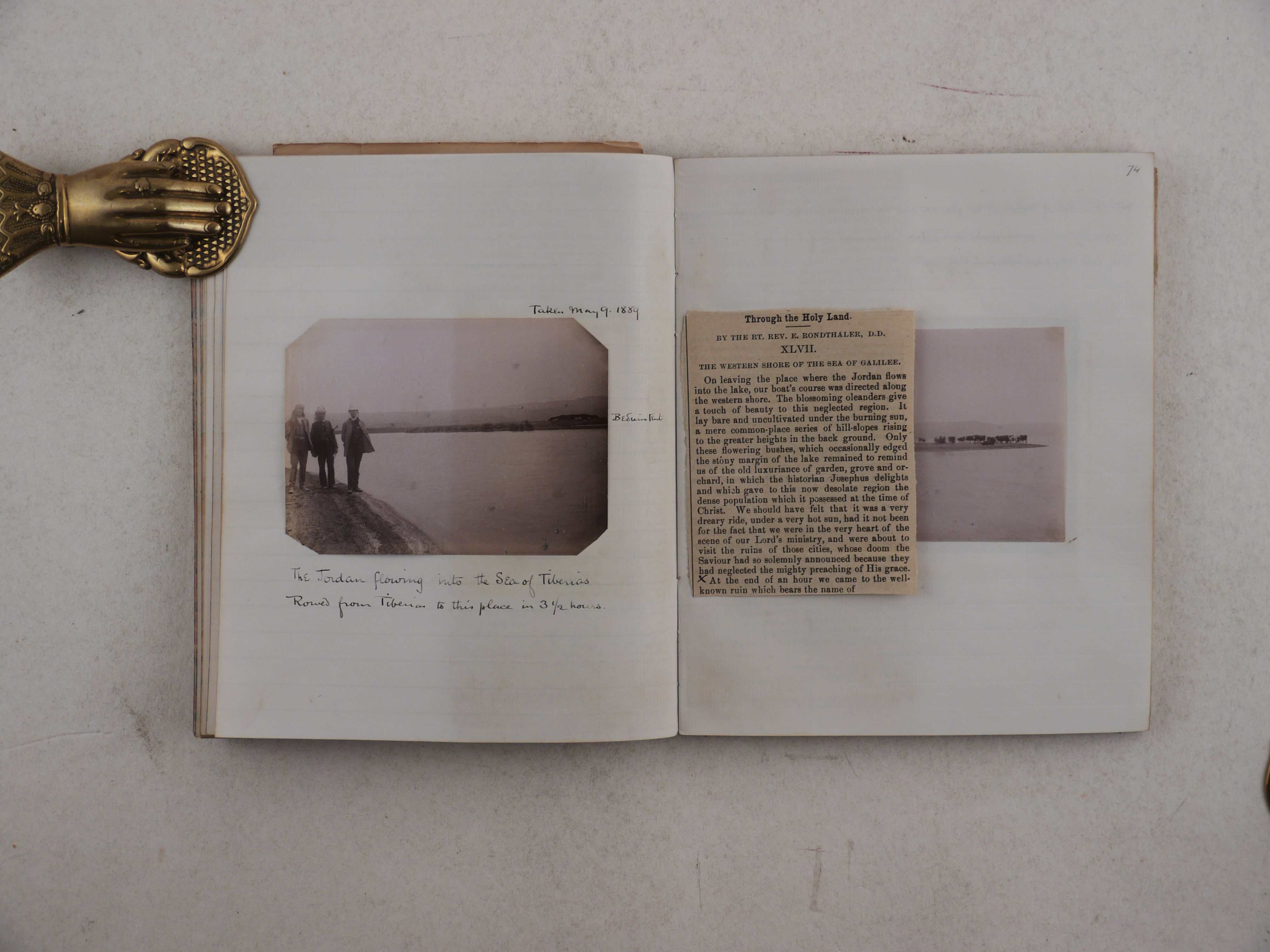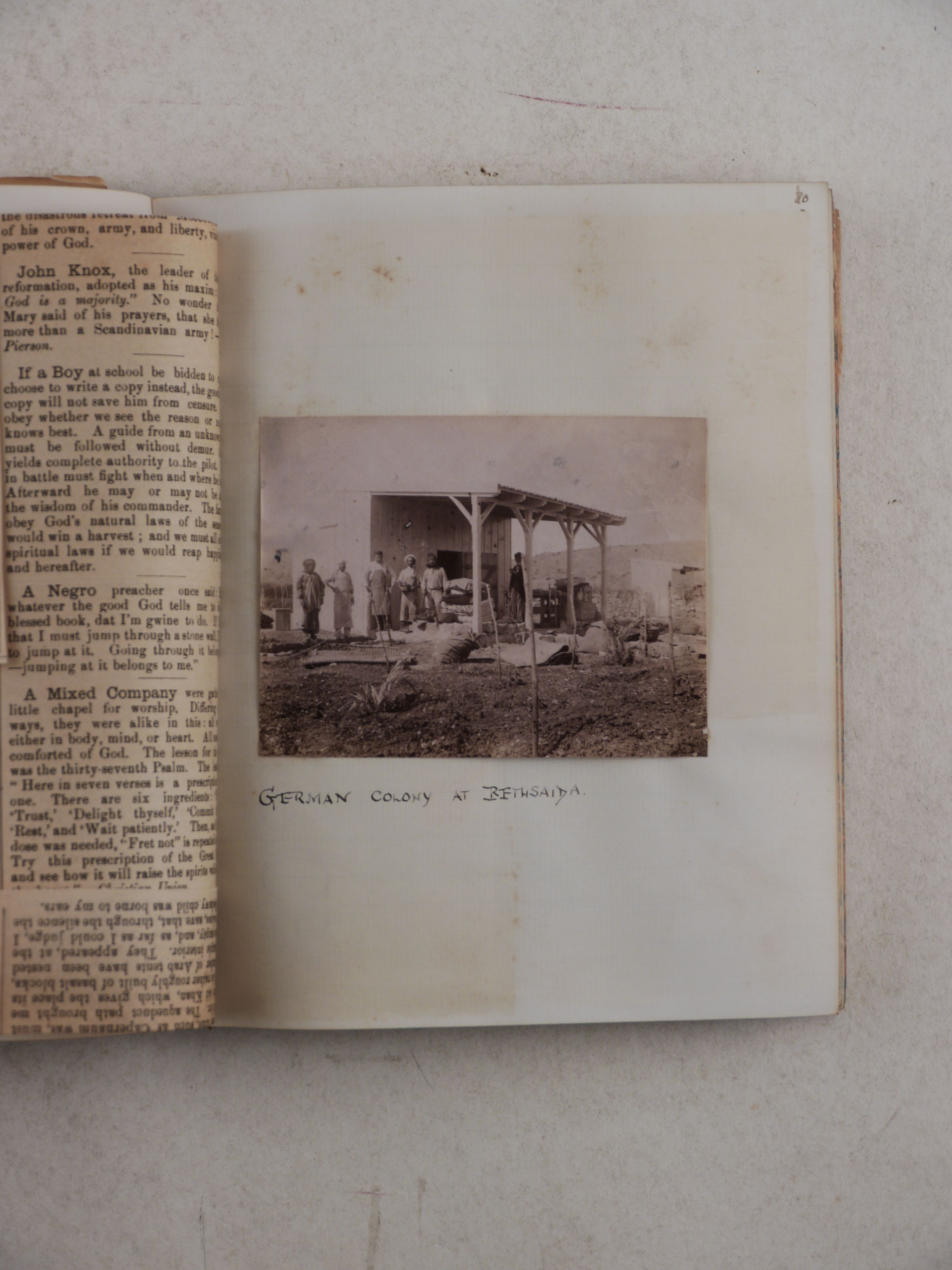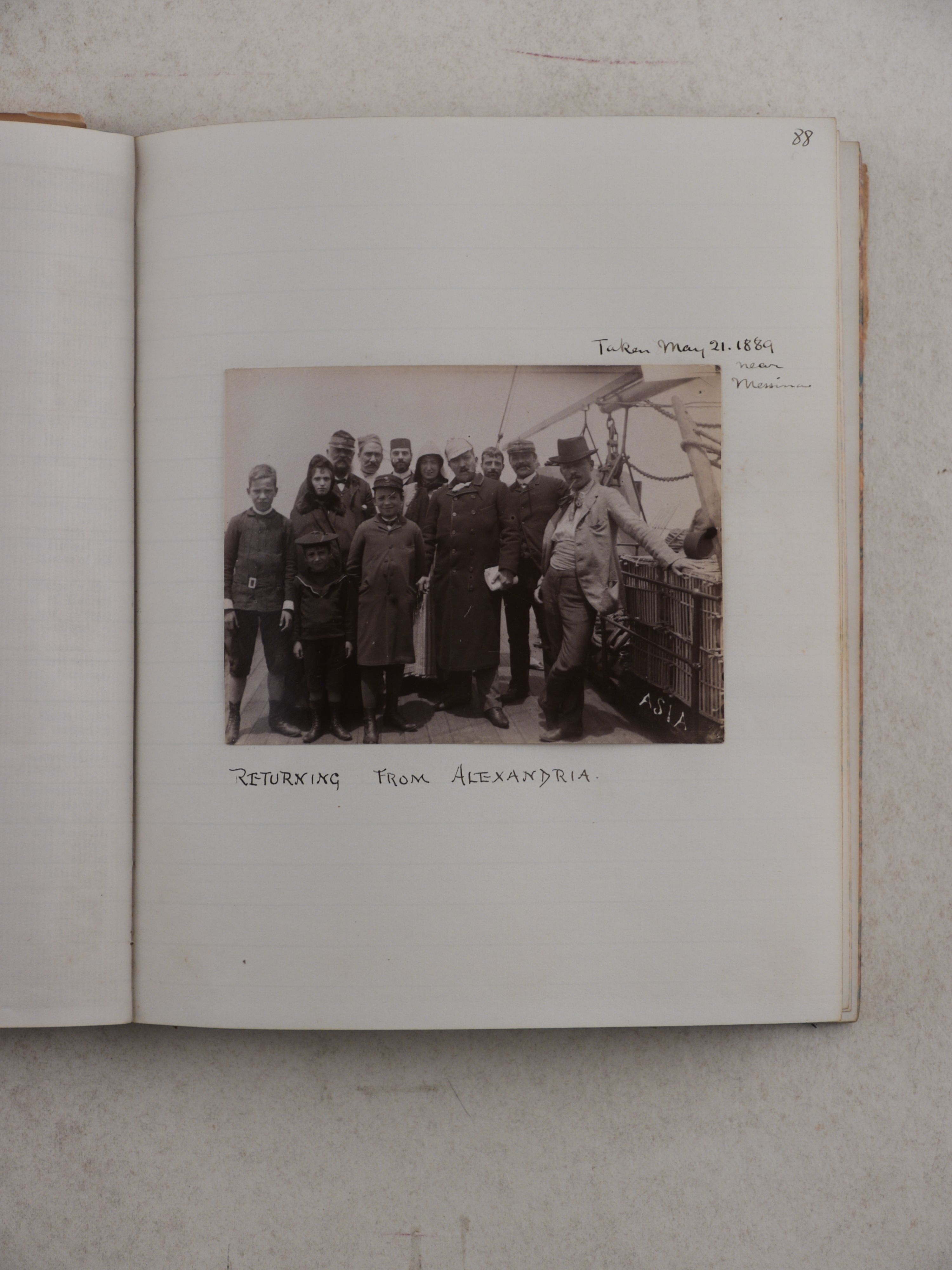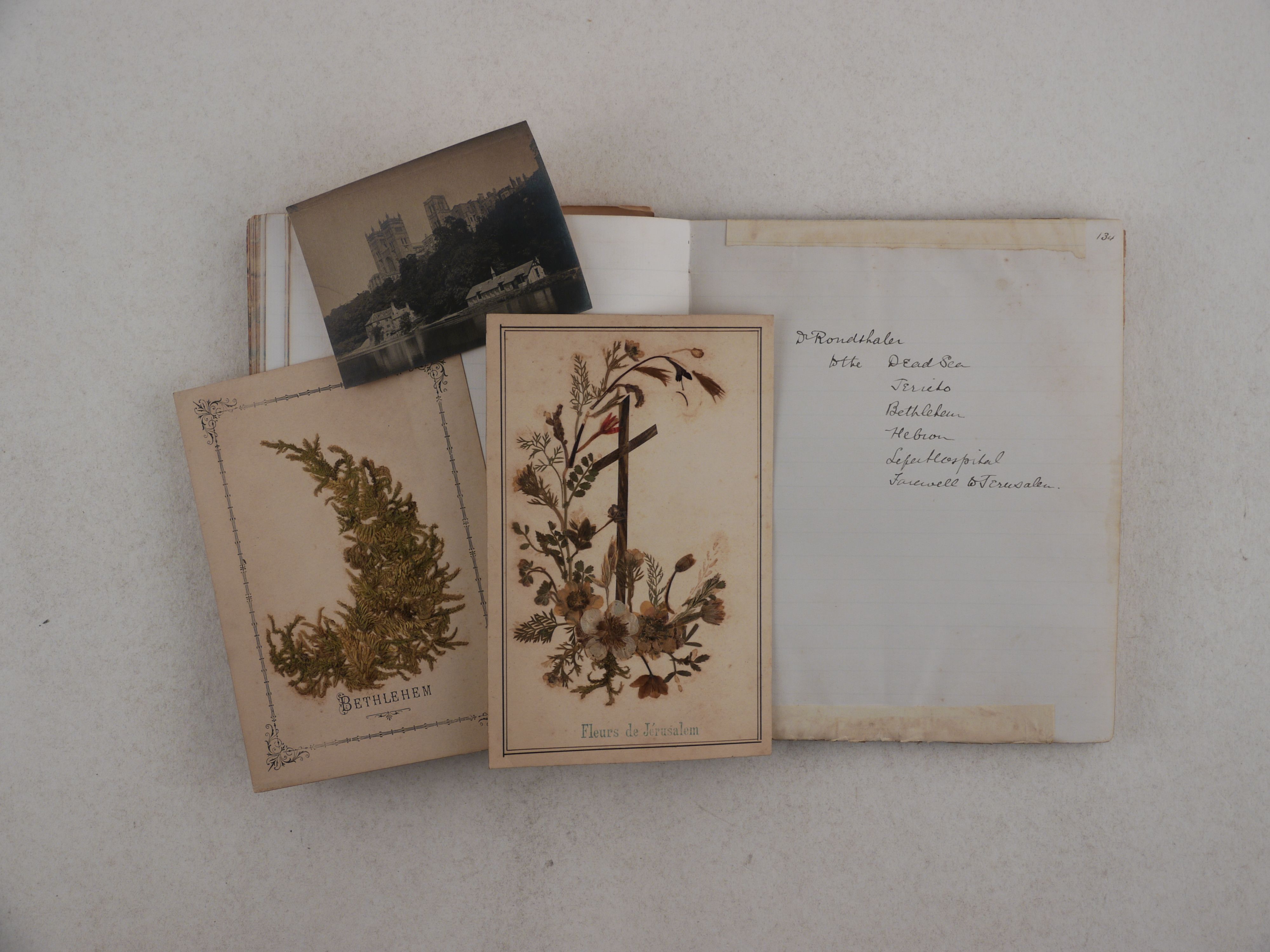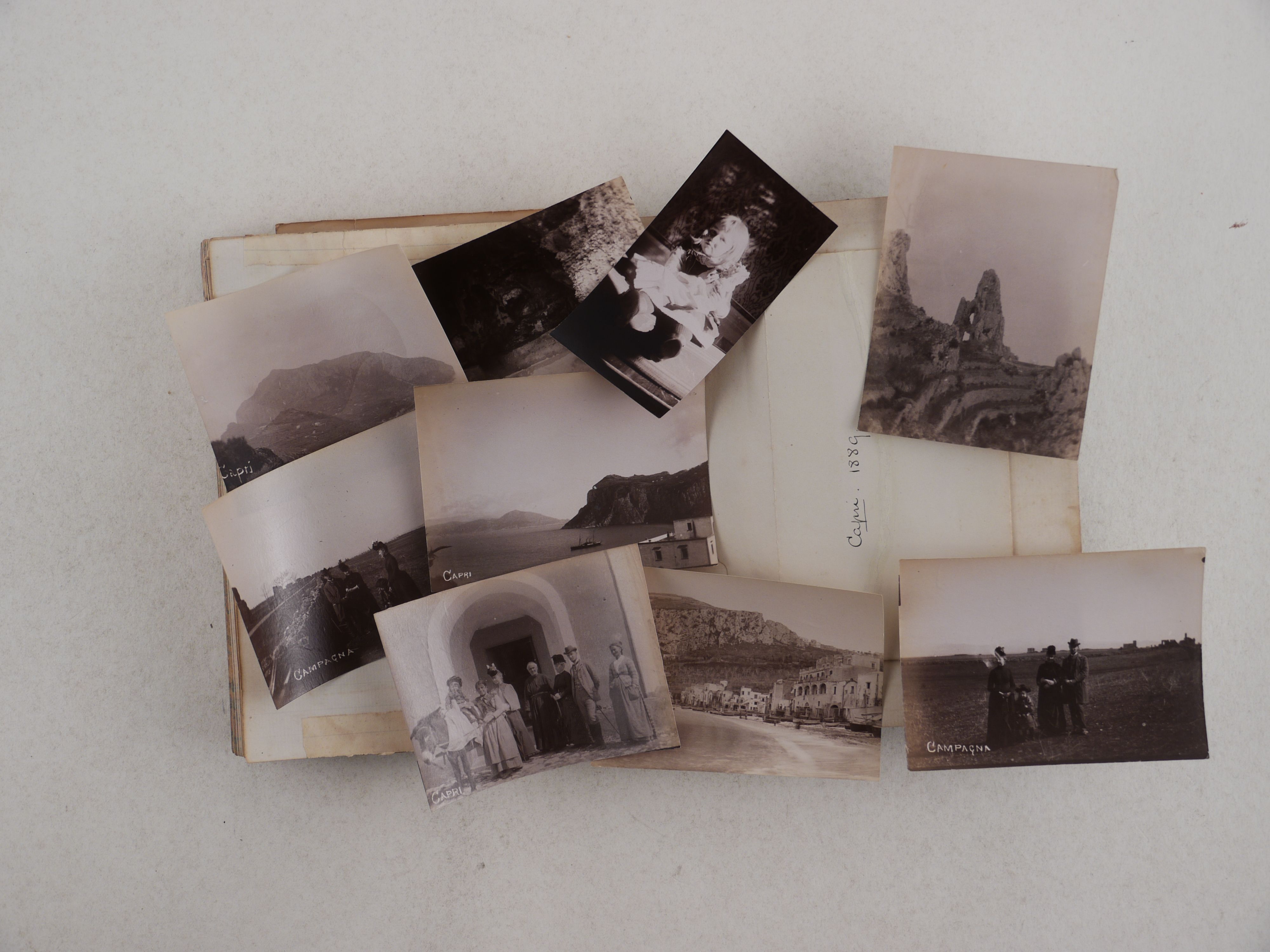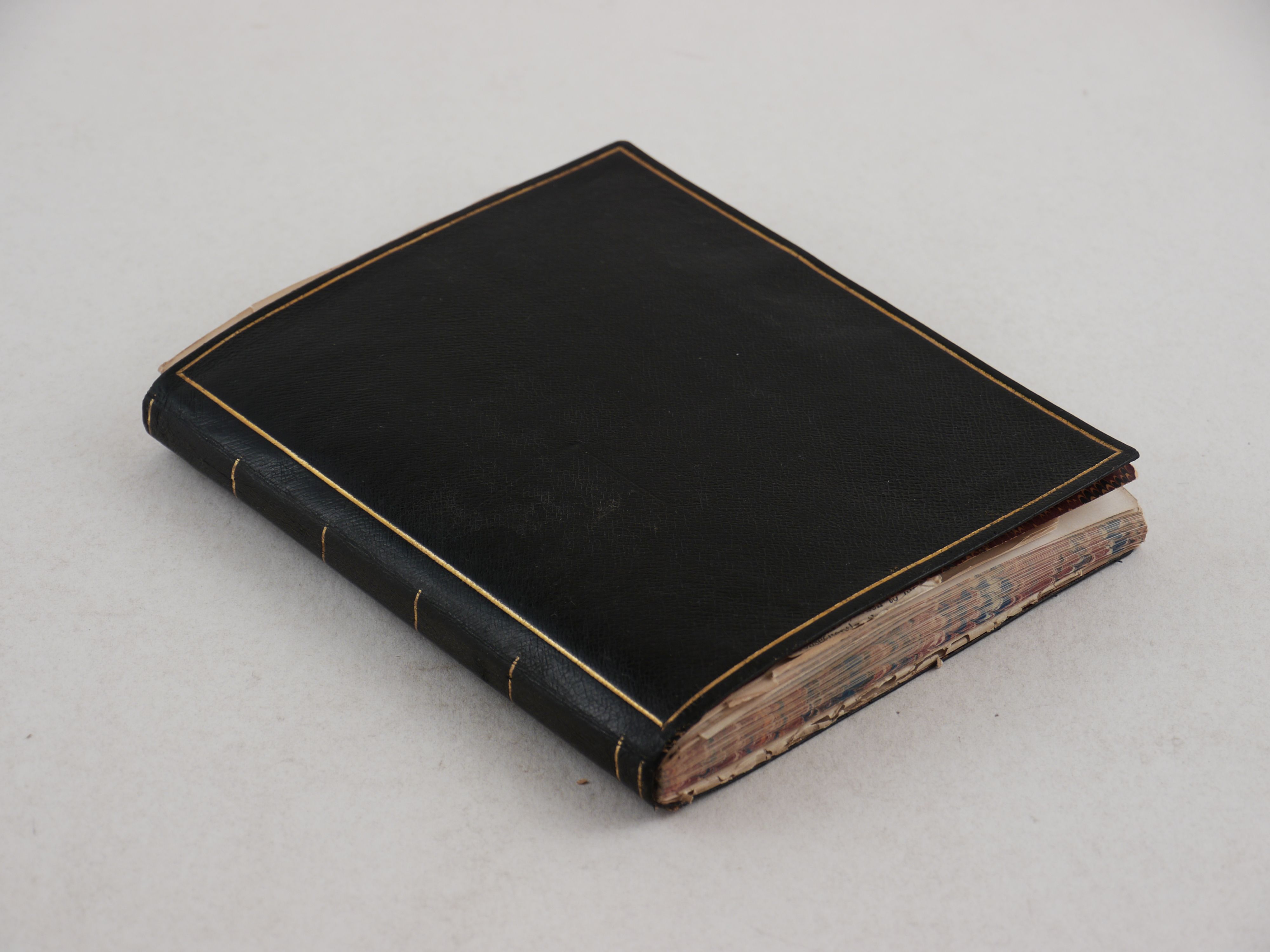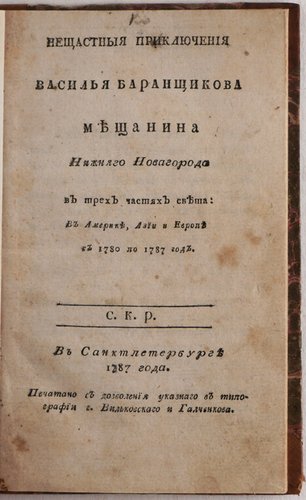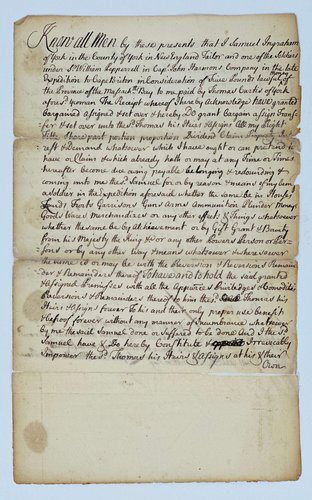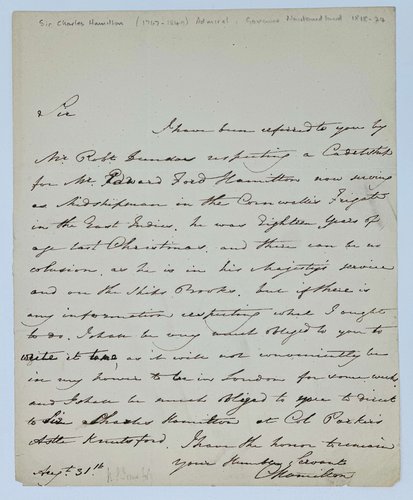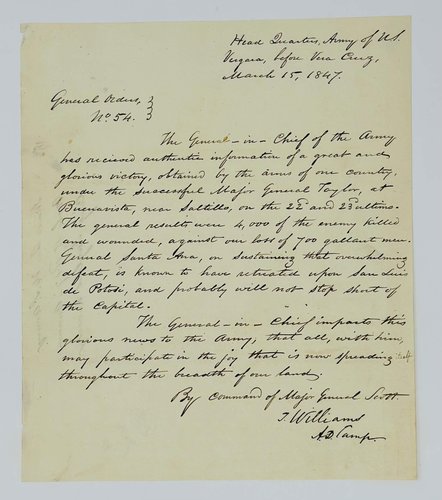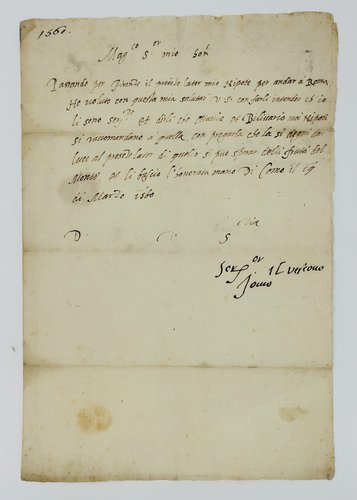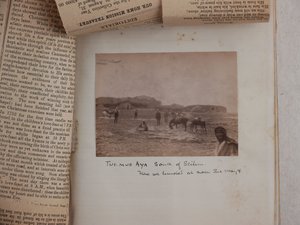
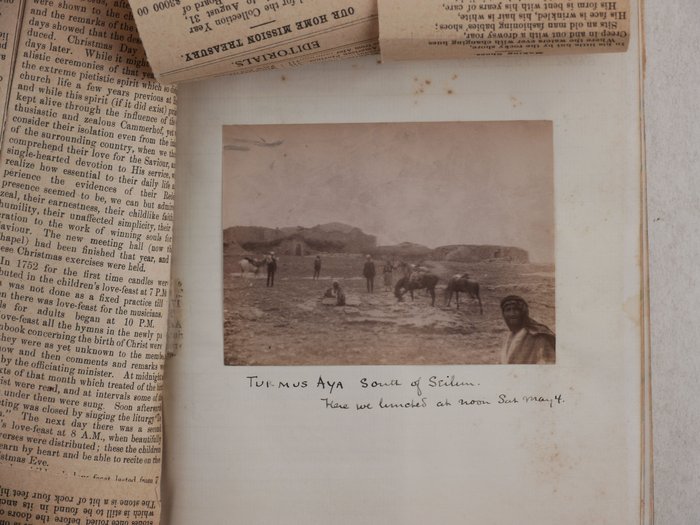
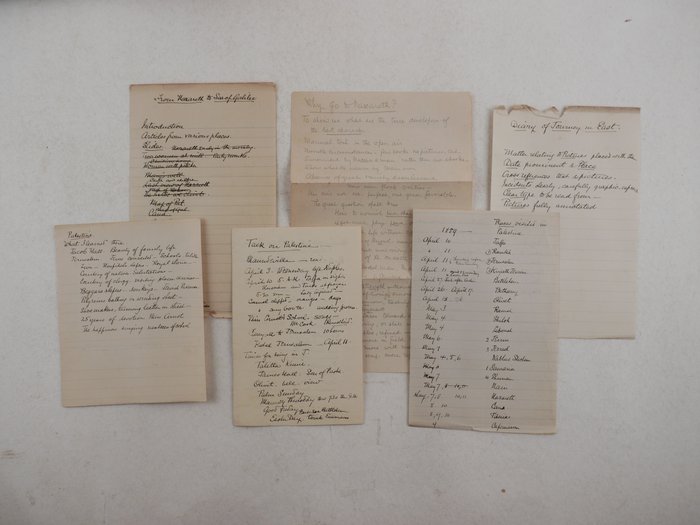
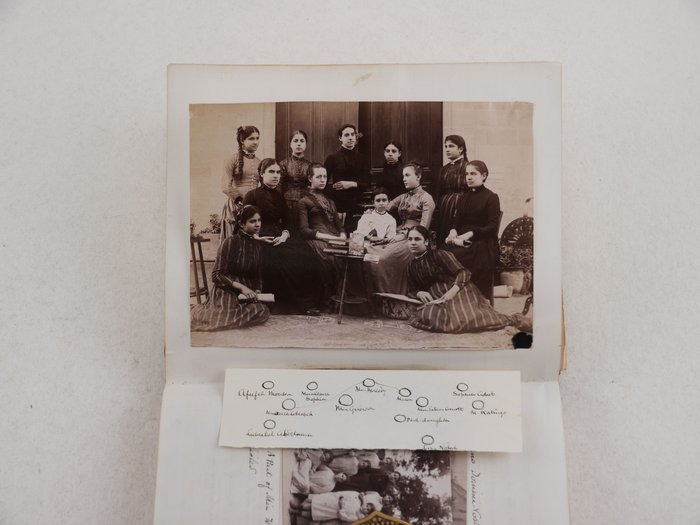
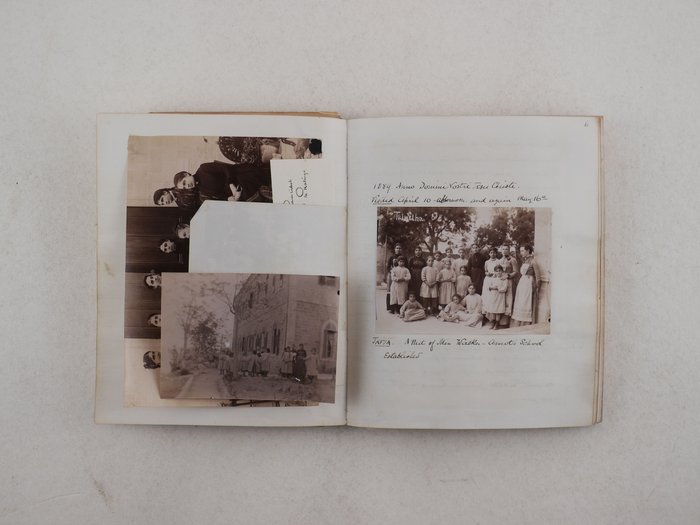
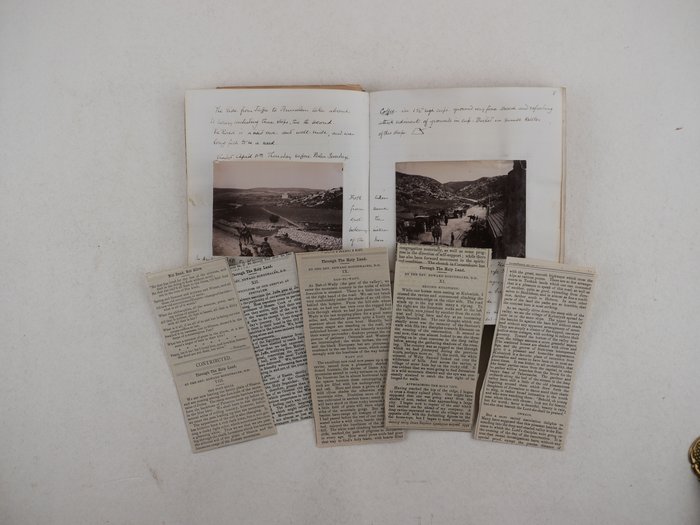
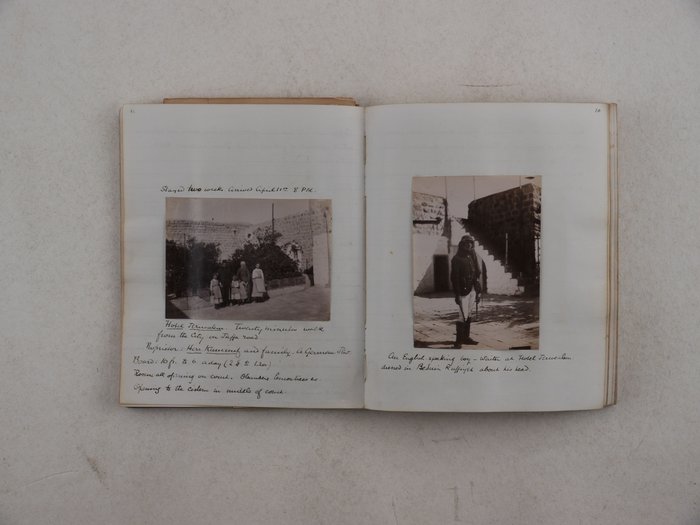
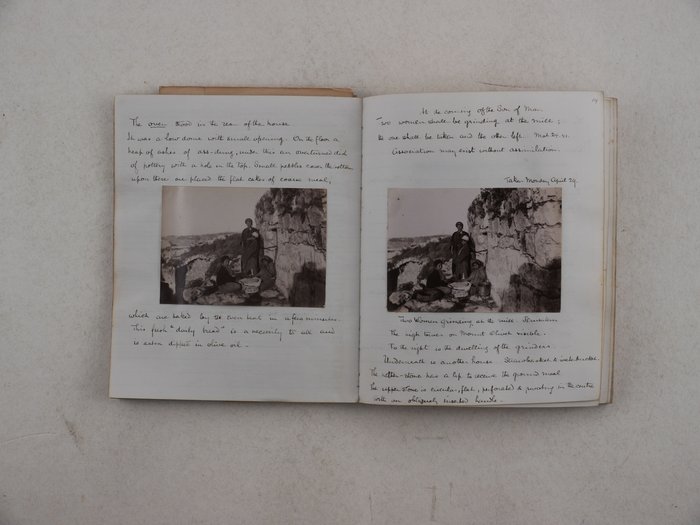
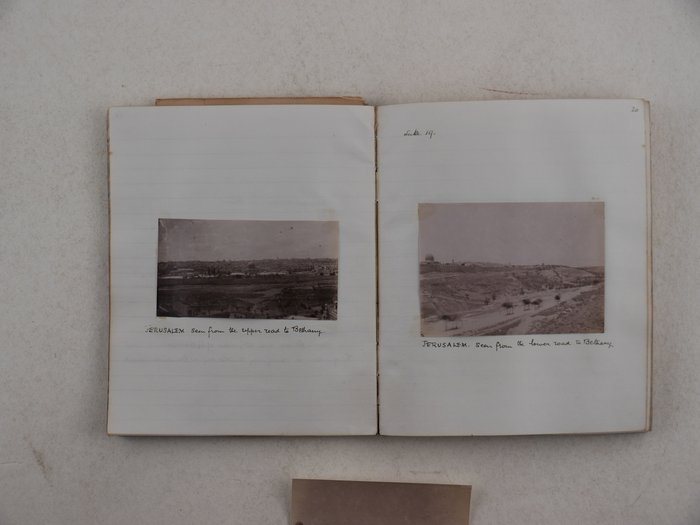
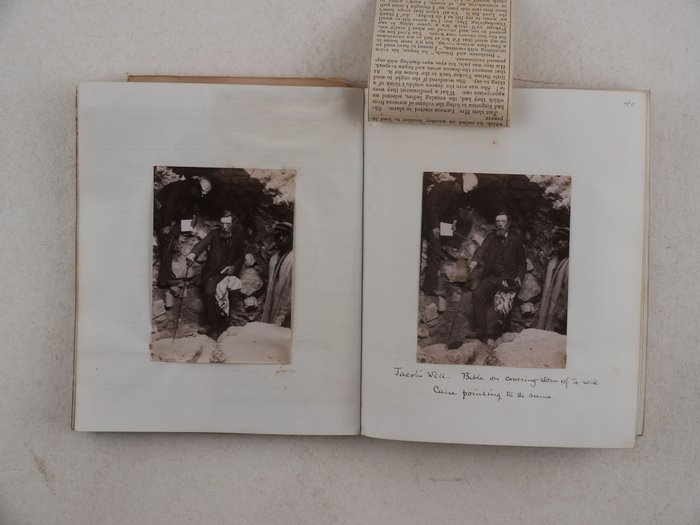
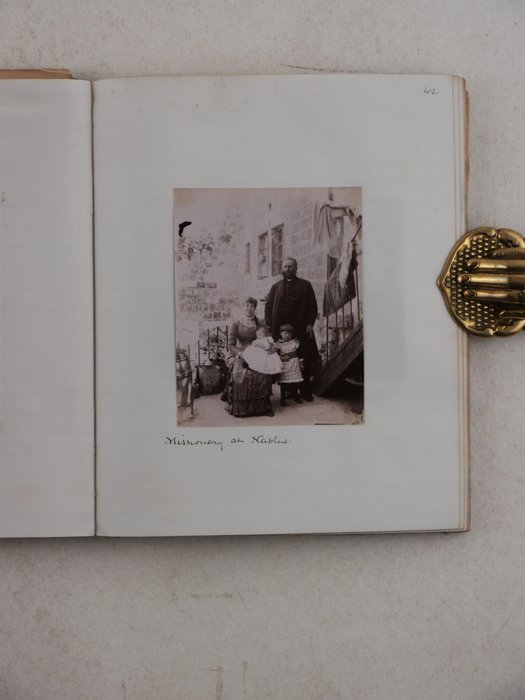
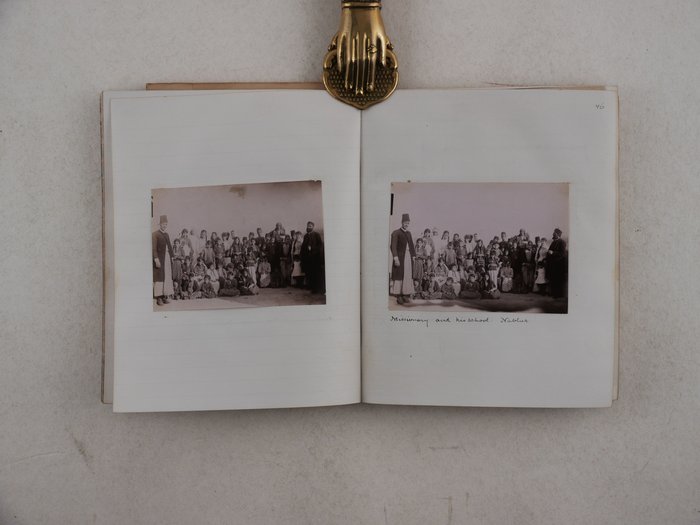
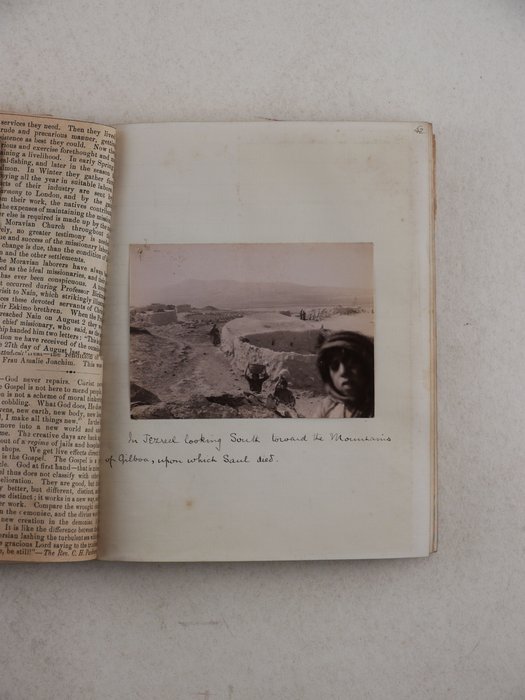
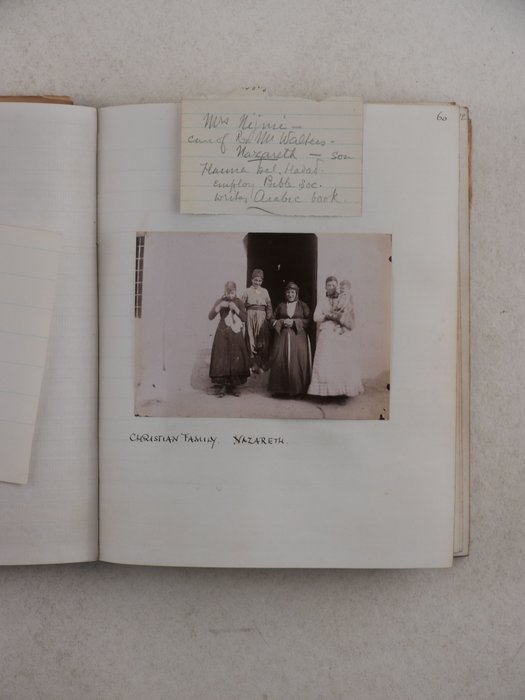
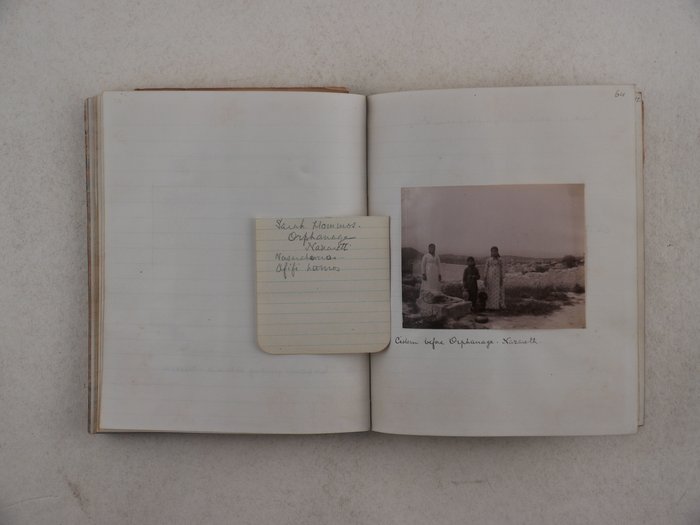
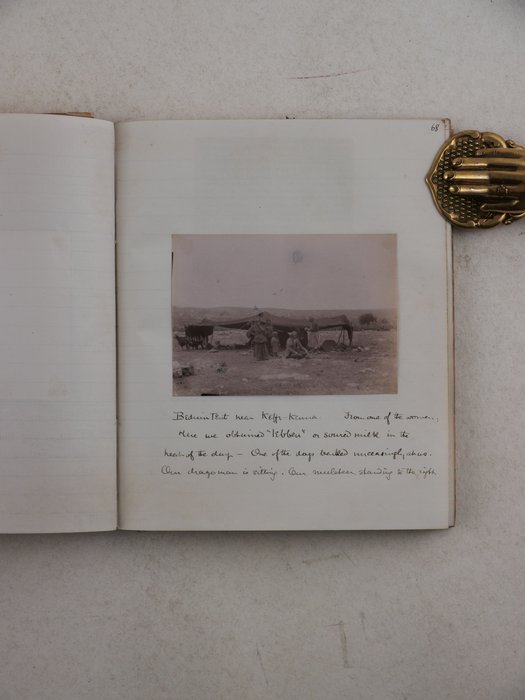
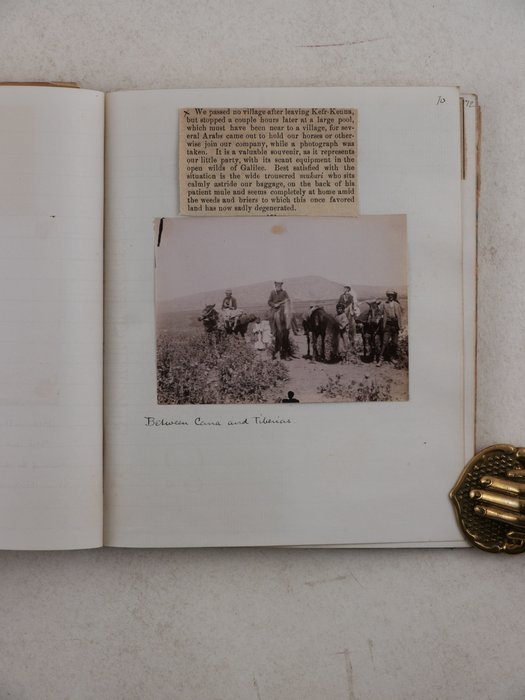
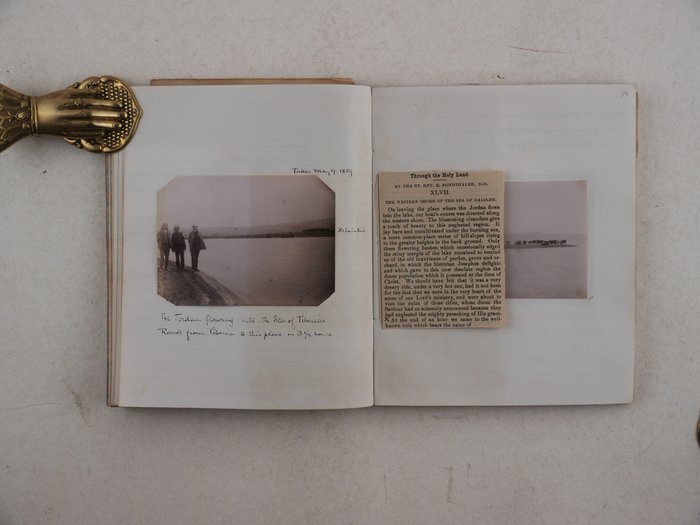
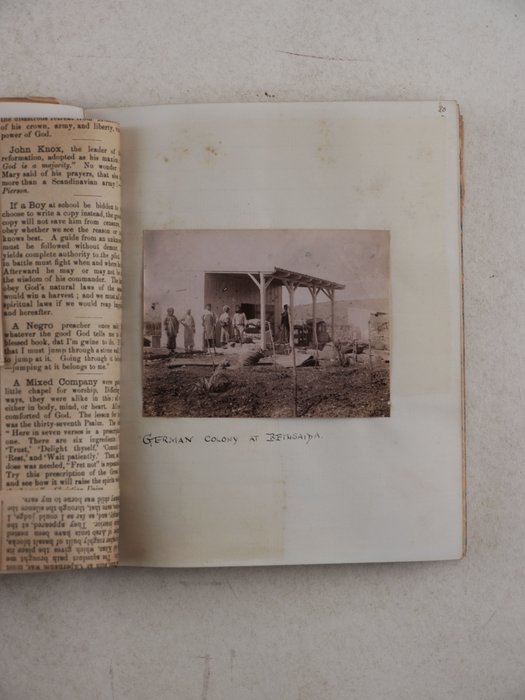
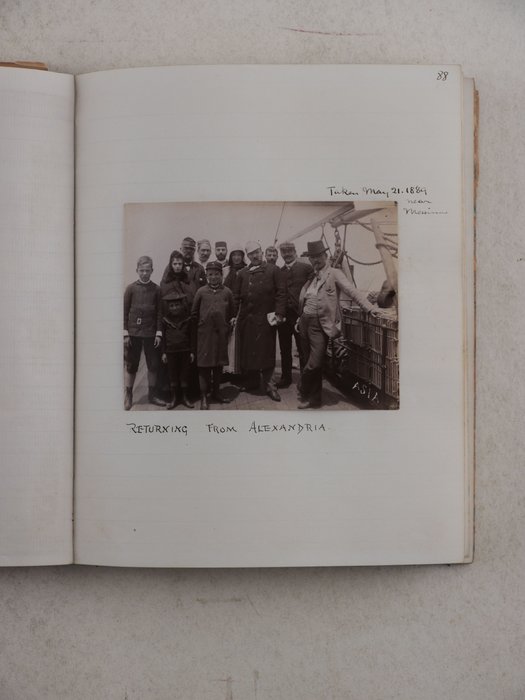
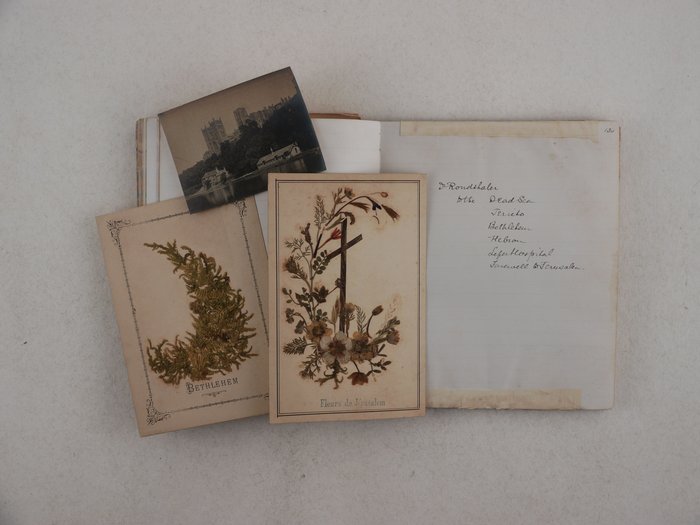
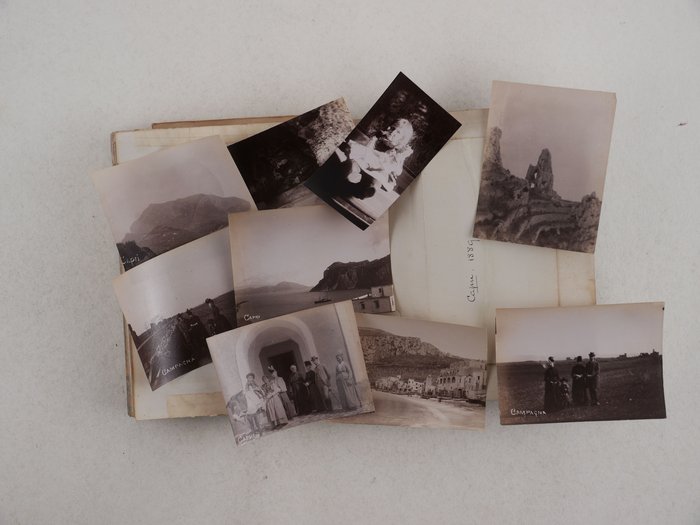
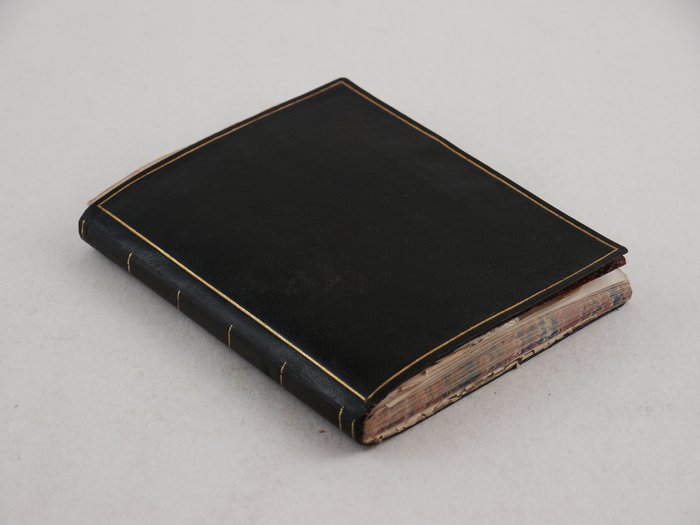
#PB72
Ca. 1889
Octavo (ca. 20x16 cm or 7 ¾ x 6 ¼ in). 68 watermarked creamy laid paper leaves (19 blank), with period ink numbers in the right upper corners. With 78 original albumen photographs (60 mounted or tipped in and 18 loosely inserted), including one large image ca. 12x17 cm (4 ¾ x 6 ½ in) and two small images ca. 4x4,5 cm (1 ½ x 1 ¾ in); the rest of the photos are ca. 8x11 cm (3 x 4 ¼ in) or slightly smaller. Most photos are with period manuscript ink captions by McCrackan on the mounts or versos; many images are also with manuscript ink dates from April to May 1889; ca. ten photos are also captioned in negative. With over thirty newspaper clippings (mounted and loosely inserted) with Rondthaler’s account of the trip, from the “Moravian” newspaper (Bethlehem, Pa, ca. 1889-1891). With six loosely inserted leaves of writing paper of various sizes, with McCrackan’s manuscript notes, titled “Palestine: what I learned there,” “From Nazareth to Sea of Galilee,” “Talk on Palestine,” “Places visited in Palestine,” “Why go to Nazareth?” and “Diary of Journey in East.” With two dried specimens of flowers and leaves of Palestinian plants, mounted on the cards, loosely inserted at the rear. Period black full sheep journal with decorative gilt-lettered borders on both boards and the spine; decorative endpapers; all edges coloured. One image (apparently, a printed postcard) was previously removed from the journal, a few photos mildly faded, but overall a very good historically interesting photo illustrated journal.
Historically interesting original journal with 78 rare albumen snapshot photographs, supplemented with extensive manuscript captions and notes, numerous newspaper clippings and dried plant specimens, which comprise the account of an 1889 trip to the Holy Land by two American clergymen. The journal was compiled by John Henry McCrackan, a member of the Episcopal Church in the United States, who then served as an assistant at the Christ Church Cathedral in Hartford, Connecticut.
The photographs and accompanying materials cover McCrackan’s travel from April 11 to May 21, 1889, when he went from Jaffa to Jerusalem and Bethlehem, thence to Nazareth and the Sea of Galilee, and back via Mount Carmel and Haifa. On the way from Jerusalem to Nazareth and back, McCrackan was accompanied by noted Moravian pastor and future bishop of the Salem Moravian Congregation (since 1891), Edward Ronthaler, who visited the Holy Land with his son, Howard Edward Rondthaler (1871-1956).
The journal opens with four group portraits (two identical) of female students and teachers from “Miss Walker-Arnot’s [Tabeefa] School” in Jaffa, including a large photo with all girls and the teacher identified on a loosely inserted piece of paper. Tabeefa School was founded in 1863 by Jane Walker-Arnott under the auspices of the Church of Scotland and continues to work today as a co-educational school.
Other interesting images include views of Jerusalem and its environs: “Bab el Wady = The Gate of the Valley, about half way between Jaffa and Jerusalem,” the interior of the Anglican Christ Church where “I had the great privilege of worshipping three Sundays” (p. 15-16), the Mount of Olives and the Garden of Gethsemane, two general views of Jerusalem taken from the upper and lower road to Bethany, the cloister of the Catholic Church of the Pater Noster on the Mount of Olives, Bethany, the house of Martha and Mary, the tomb of Lazarus and the interior of a “Lutheran chapel in Bethlehem.” Four images portray “Herr Kaminitz and family, a German Jew” – “the owner of Hotel Jerusalem, twenty minutes walk from the City on Jaffa road;” “an English speaking boy-waiter at Hotel Jerusalem;” “Bayer and family” (the owner of the Prussian Hospice in Jerusalem); and “two women grinding at the mill, Jerusalem” (an illustration to the words of Jesus from the Gospel of Matthew).
Over thirty photos illustrate the trip to Nazareth and the Sea of Galilee and show the biblical Shiloh and the site of Jacob’s Well near Nablus (both in modern-day West Bank), two portraits of Rev. Edward Ronthaler posing inside the Jacob’s Well, four portraits of a “native Baptist” missionary in Nablus, posing with his family, inside the church and with his parish (see more about the encounter in Rondthaler’s account, mounted on p. 38), the ruins of Samaria (Sebastia, West Bank), the spring at Sileh et Dahr north of Samaria; Jezreel and Shunem (Yizre’ela and Sulam, both in north-eastern Israel). The other photos were taken in famous towns and villages, related to Jesus’s ministry around the Sea of Galilee and show Nain (Nein), Nazareth (Mary’s fountain, a Christian family, “two women grinding at the mill,” a “cistern before Orphanage”), “beduin tent near Kefr Kenna” (biblical Cana), “Kurun Hattin, Mount of the Beatitudes” (the Horns of Hattin, Lower Galilee), Capernaum (the ancient slab from Tell Hum), Bethsaida (the traveller’s boat and local crew, pioneers of the “German colony”), and Tiberias (“looking north from the roof of the Latin monastery”). Two photos portray McCrackan, Rondthaler, and his son mounted on horses “near Mount Carmel on the way to Haifa from Nazareth.”
The photos are supplemented with McCrackan’s manuscript captions and notes, as well as with about thirty-five clippings from the “Moravian” newspaper (Bethlehem, Pennsylvania, ca. 1891-1893) with Rev. Edward Rondthaler’s detailed account of the travel to the Holy Land. At least one of the clippings mentions “a young Episcopal clergyman, Mr. McCrackan,” who joined Rondthaler and his son on the trip to Nazareth (clipping “XXXVI. Our journey northward,” p. 32 of the journal). The other clipping, talking about the excursion to the Jacob’s Well, mentions “a precious memorial of our visit in the shape of a photograph” (clipping “XXXVIII. Nabulus, Mount Gerizim and Jacob’s Well,” p. 40 of the journal). The exact photo of Rondthaler posing in Jacob’s Well is mounted on the same page.
Six loosely inserted leaves of writing paper contain McCrackan’s notes for his future talk about his travel to the Holy Land. The titles of the notes are: “Palestine: what I learned there,” “From Nazareth to Sea of Galilee,” “Talk on Palestine,” “Places visited in Palestine,” “Why go to Nazareth?” and “Diary of Journey in East.” The journal also contains two keepsake cards with the dried specimens of moss from Bethlehem and “Fleurs de Jérusalem.”
The collection also includes four group portraits of the passengers on board the steamer “Asia” which took McCrackan back to Italy from Alexandria. Nine photos loosely inserted in the envelope mounted at the rear are the views and portraits taken by McCrackan in Rome and on Capri in March 1889, showing the Appian Way, the harbour of Capri, the interior of the “Cave of Mithras” and portraits of McCrackan, his wife Cora Gertrude Bailey (1862-1924) and their three-year-old daughter Gertrude.
Overall a historically interesting, content-rich original source on the history of American pilgrimages to Palestine in the 19th century.
“The Rev. John H. McCrackan was born in New York in 1856 and was educated in Europe. On his return to this country, he entered Trinity College and graduated in 1882. His first call was to Christ Church, in Hartford. He was assistant to the Rev. William F. Nicholas, now Bishop of California. His health failing, he made a trip to Europe, and later to California. He had a charge in Rome, and three years ago became Chaplain of the [American Church of the Ascension] in Munich” (Death list of a Day// The New York Times. 24 July 1906, p. 7).
Edward Rondthaler, “Moravian bishop, pastor, administrator, teacher, historian, editor, writer, linguist, and community leader, was born at Schoeneck, Northampton County, Pa., in the parsonage of Schoeneck Moravian Church, which his father, Edward Rondthaler, Sr., served as pastor from 1841 to 1844.” He graduated from the Moravian Theological Seminary (Bethlehem, Pa.) and later the University of Erlangen, Germany. In 1877, he became pastor of the Salem Moravian congregation (North Carolina) and remained there until the end of his life, serving in various capacities, including the principal of Salem Female Academy, member and president of the Provincial Elders’ Conference, a member of the Moravian College and Theological Seminary Board of Trustees, Chairman of the Salem Boys' School Board of Directors, &c. He became a bishop of the Moravian church in the United States in 1891. In 1930, the Winston-Salem Chamber of Commerce named Rondthaler the city's Outstanding Citizen and awarded him its Service Cup for "meritorious, unselfish and distinguished community service." (see more: Dictionary of North Carolina biography).

